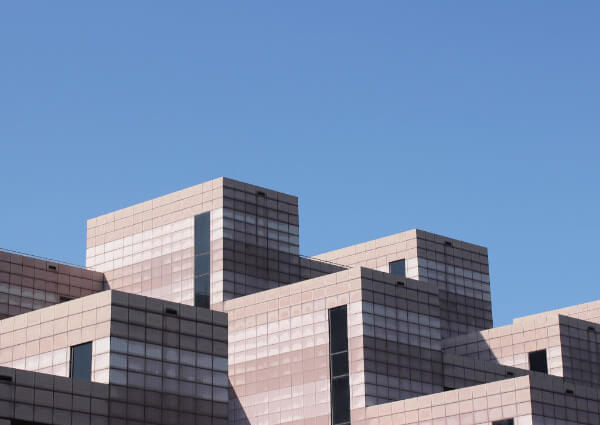Home » 2021 (Page 2)
Yearly Archives: 2021
Animating Life: 9 Real-World Buildings Designed Like Disney Movie Sets
Architects: Want to have your project featured? Showcase your work through Architizer and sign up for our inspirational newsletter.
Apart from swoon-worthy characters and catchy songs, Disney movies are also well known for their impeccable graphics and impressive architecture. From tiny homes in the woods to grand royal castles, these movies have always made users wish they could live in these structures, even if it is just for a day. Princess Aurora’s room from Sleeping Beauty, the candy house from Hansel and Gretel and the Cinderella Castle are just a few examples — and some architects have been taking note.
But while it might be difficult to run along with Elsa on the ice-sculpted staircase or hide with Winnie the Pooh in his treehouse, there are some real alternatives that are no less magical. Below is a list of a few structures found across the world that exhibit forms, characteristics or aesthetics that resemble some iconic Disney homes.
Rapunzel’s Tower from Tangled
View this post on Instagram
A post shared by *•.¸♡ Disney fan time ♡¸.•* (@disney_fan_time)
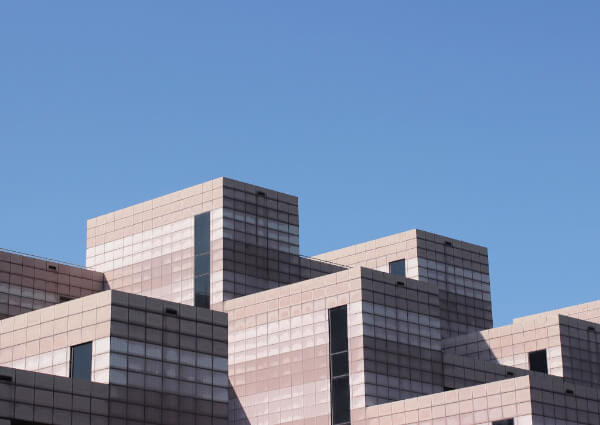

Ann Hamilton Tower by JENSEN Architects, Geyserville, California
Rapunzel’s tower has long been associated with entrapment and, of course, wishes for long golden locks. While charming and beautiful, the tall structure standing alone in the woods cannot be mistaken for anything but the home of a hermit who wishes to stay away from society.
In the Ann Hamilton Tower by JENSEN Architects, we see the sense of seclusion and detachment in its bare concrete façade and concealed fenestrations. But unlike the Disney version, this performance space features large double helix stairs that invited visitors to stand on and observe performers on the other end, allowing the two sides interact with one another (albeit at a distance).
Fa Family Home from Mulan
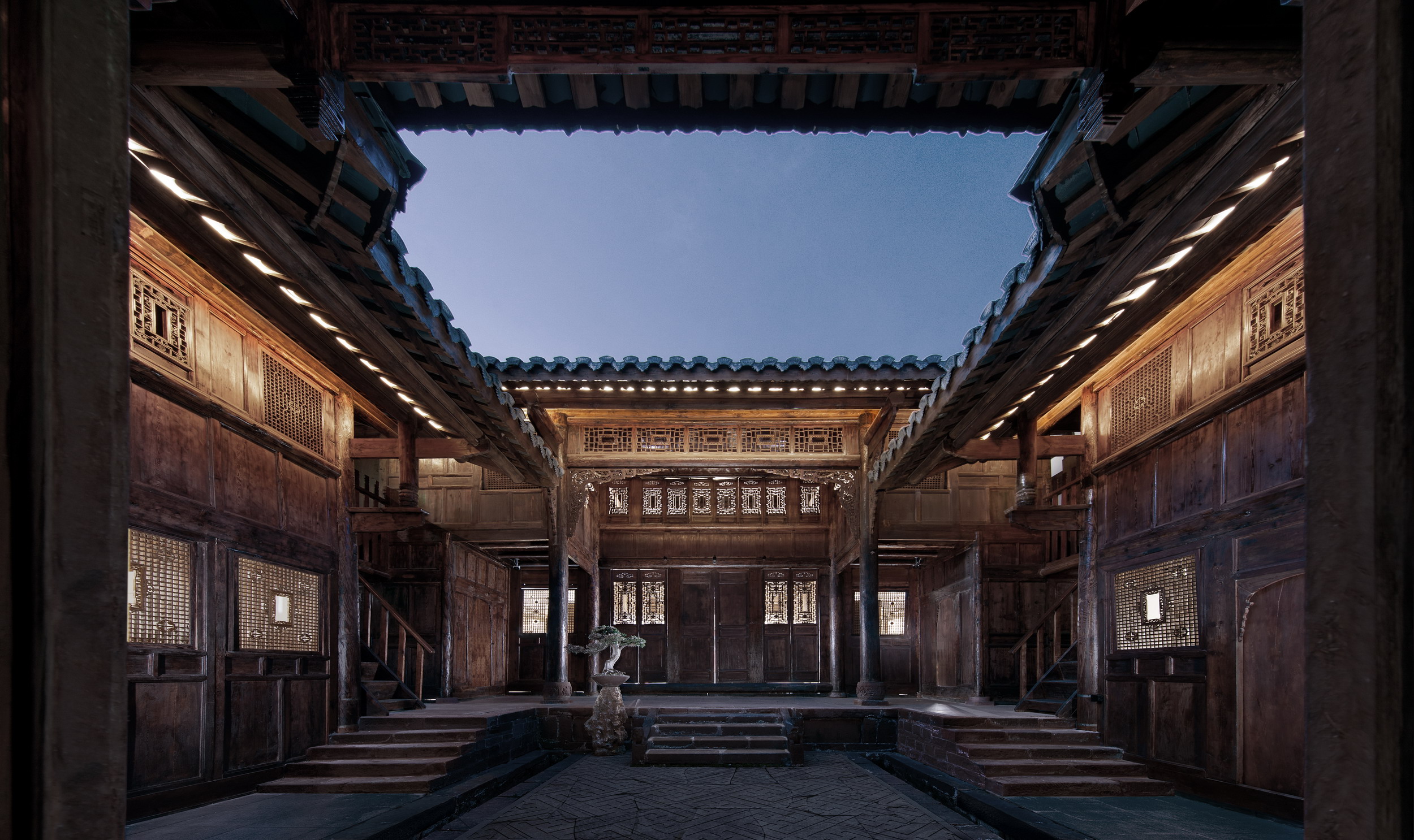

Qionghai Lake 17° General Hall Hotel by Beijing Puri Lighting Design Co.,LTD. Xichang, China
Mulan’s home in the 1998 animated film is laid out in a rectangular plot with a central courtyard. Just as in the layout, with its sloping roofs and red accents, the form of the building also looks to traditional Chinese residential architecture; it even comes with an adjoining stable and a serene garden with a river flowing through.
Qionghai Lake 17° General Hall Hotel in Xichang also stays true to its heritage by keeping intact the wooden structure and details that have existed on the site for over a century. Beijing Puri Lighting Design Co.,LTD. retrofitted the former residence of Liu Xiangzhi, an official in the Qing Dynasty, to create a dreamlike experience that is rooted in history. Warm white lights in the forms of dots, lines and planes are added throughout the complex to accentuate the architectural details of the hotel.
Elsa’s Castle from Frozen


IceHotel365: Dreamscape by Atmos Studio, Jukkasjärvi, Sweden
Whether it is due to its catchy tune or to the stunning graphics, Elsa singing “Let It Go” as she strides along a snow-capped mountain to build her icy castle is a scene that is not easily forgotten. Here, she magically produces a large castle with stunning pink and blue crystalline forms and details out of thin air.
What can’t be accomplished with magic in real life, Atmos Studio does with modern temperature control methods and actual ice. Icehotel 365 in Sweden is a space where visitors can experience art in the form of frozen water and experience living in ice suites. For this hotel, Atmos created an art suite complete with a swooping staircase and icy tentacles that partition spaces and create a mystical loft for sleeping.
Cottage of the Seven Dwarfs from Snow White and the Seven Dwarfs
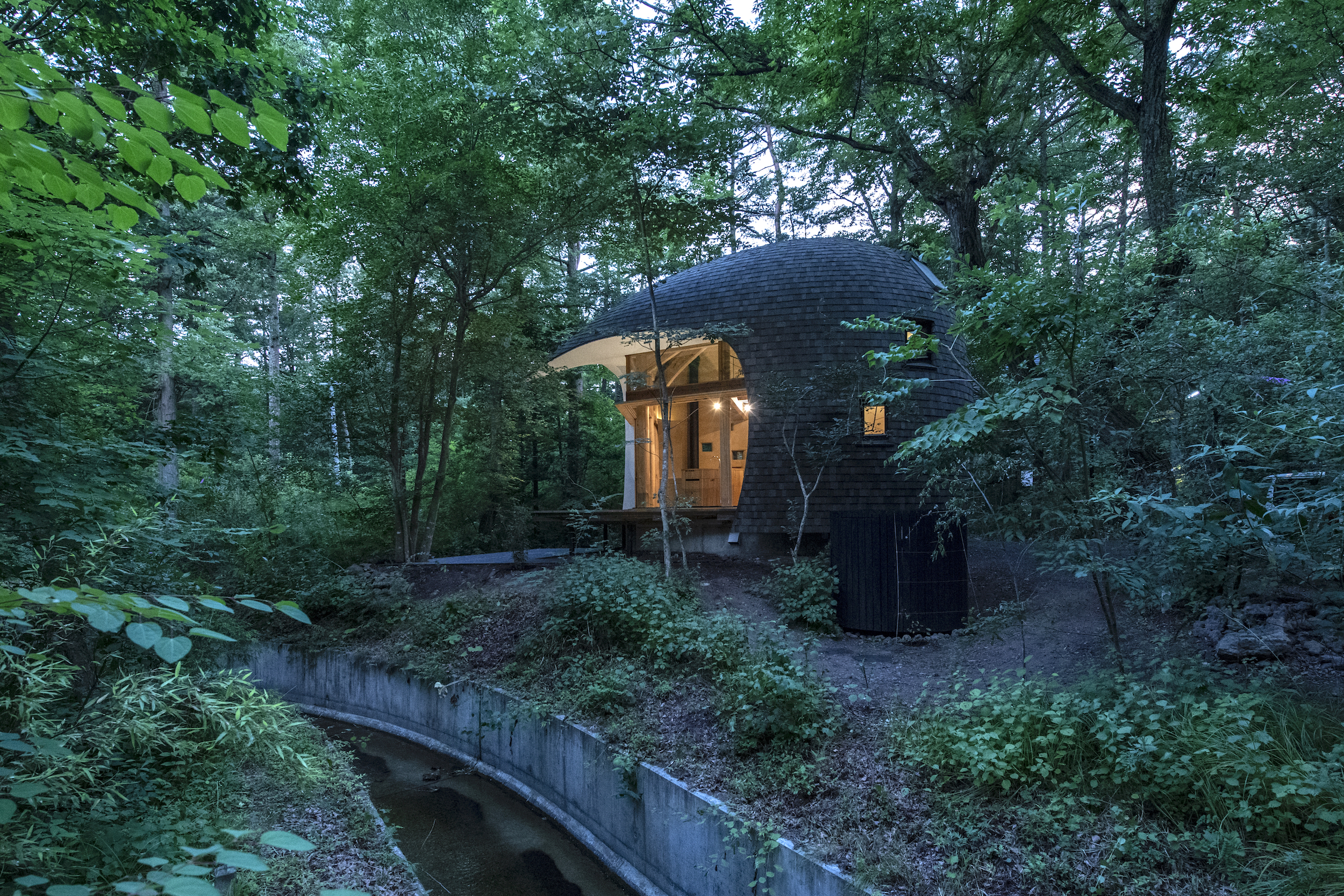
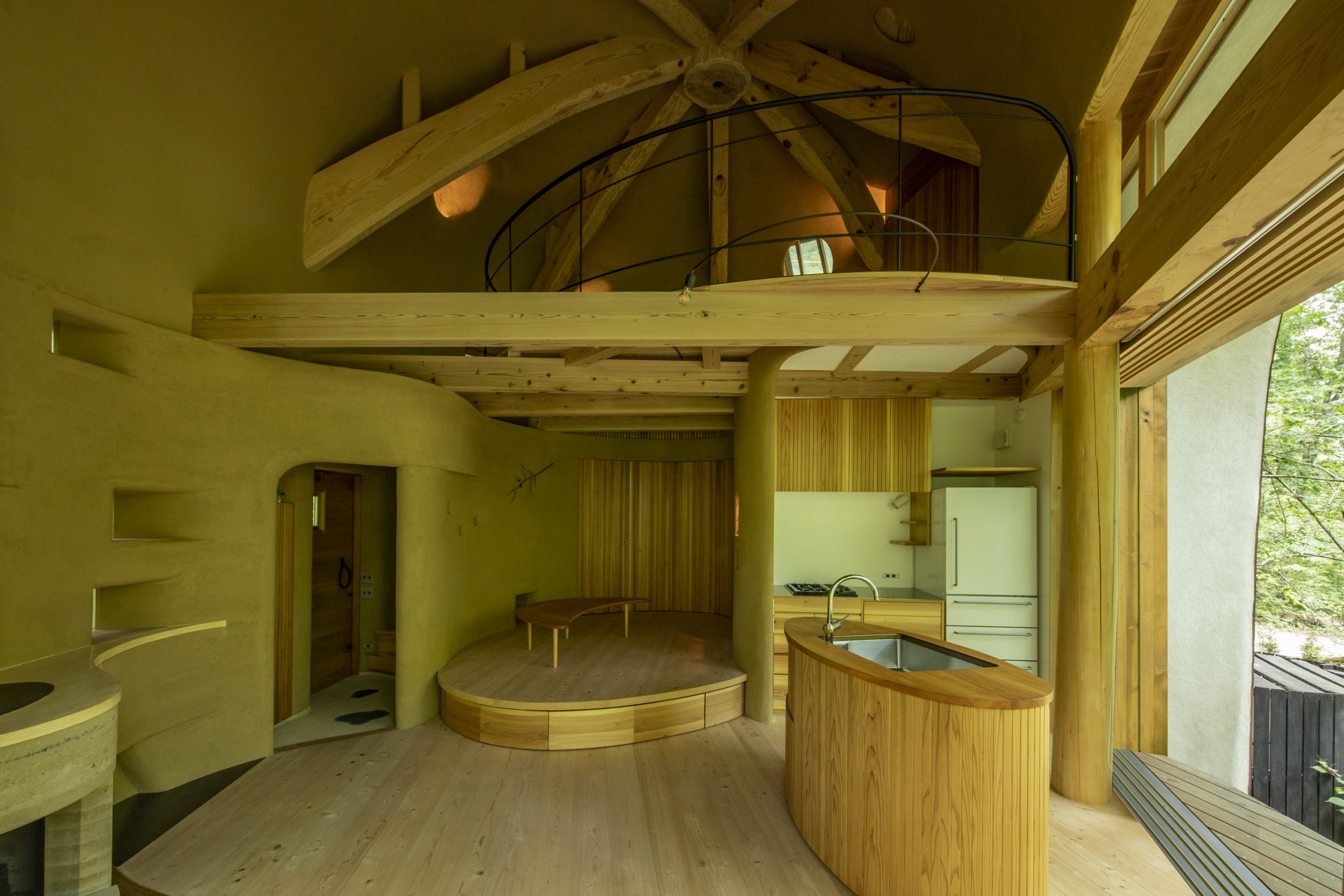
Shell House / The language of forest by Tono Mirai architects, Nagano Prefecture, Japan
When running away from her evil stepmother, Snow White found sanctuary in a quaint cottage in the woods. That forest home for the seven dwarfs was crafted using natural materials and rustic décor elements.
Likewise, in the Japanese Shell House, the language of forest provides the perfect hideout away from civilization. Its curved form partially encloses a kitchenette, island, dining area, bathroom and bedroom. Local wood, earth and manual construction methods all contribute to the project’s sustainability. A large opening on one side allows light enter the house, while the shingled cocoon on the other side helps it to blend with the surrounding forest.
The Beast’s Library from Beauty and the Beast

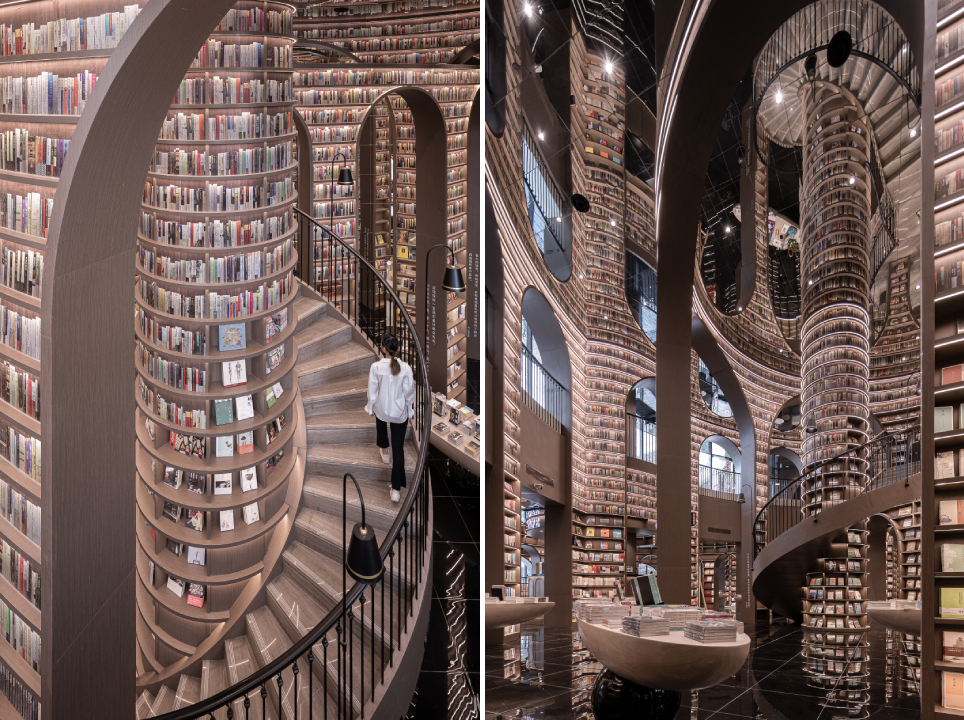
Dujiangyan Zhongshuge by X+LIVING, Dujiangyan, China
The Beast’s library has been a fantasy of many book lovers across the world. Endless stacks of books, grand spiral staircases and classic motifs and ornaments all hint at magical adventures beyond the pages of these books. A similar real-life example of a bibliophile’s paradise is the Dujiangyan Zhongshuge conceptualized by X+LIVING. Tall arches interconnect with curved shelves and dramatic staircases to create the illusion of a book-filled maze that is isolated from the outside world. The arches separate spaces and create designated pockets for different genres. Meanwhile, readers are invited to indulge their curiosity as they explore the space to find books that they love.
Pride Rock from The Lion King
View this post on Instagram
A post shared by Mufasa TheLionKing (@mufasafans)

DCIM100MEDIADJI_0195.JPG
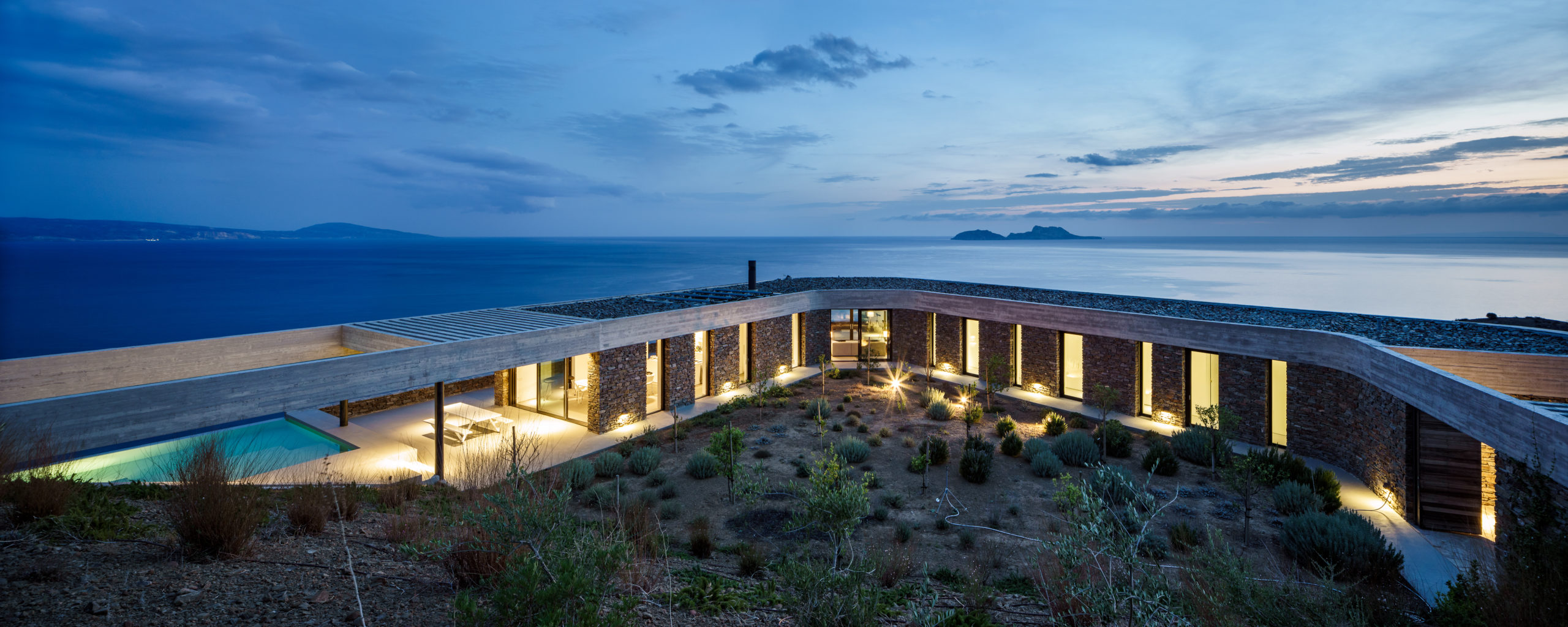
Ring House by Deca Architecture, Crete, Greece
When Simba was born, Rafiki — the mandrill who acts as advisor to the animal kingdom — trotted to the edge of the Pride Rock to introduce the future ruler to the animals of the Pride Lands. This massive rock formation creates a perch that overlooks the entire kingdom; the natural monument allows the ruling lions of the pride to observe the entirety of their land.
In a not dissimilar manner, Ring House by Deca Architecture stands alone on a hill and overlooks the endless sea on one side. The residence follows the natural contours of the hill and is a landscape preservation intervention. The house’s concrete beams provide shade while allowing natural ventilation. They are also fitted with solar panels to generate power. In addition to this, pillars covered in stone make up the external walls of the home.
Lightfoot House from Onward


The Mushroom – a wood house in the forest by ZJJZ Atelier, Jiangxi, China
In the movie Onward, Ian Lightfoot and his family live in a colorful mushroom-like house. Before their city evolved to what is a modern-day town, the creatures all lived in primitive mushroom houses in the mountains that featured wooden textures and hues.
ZJJZ Atelier’s The Mushroom is a practical and habitable version of those homes. It is a compact structure on stilts that is made of two volumes – a conical guest room with a spectacular view of the forest and a rectangular block that houses the bathing and storage facilities. There is also a loft in the cone that can be a secondary area for children. The selection of pinewood and concrete surfaces for the structure helps it become one with its surroundings, especially as these materials change tones with the weather.
King Triton’s Palace from The Little Mermaid
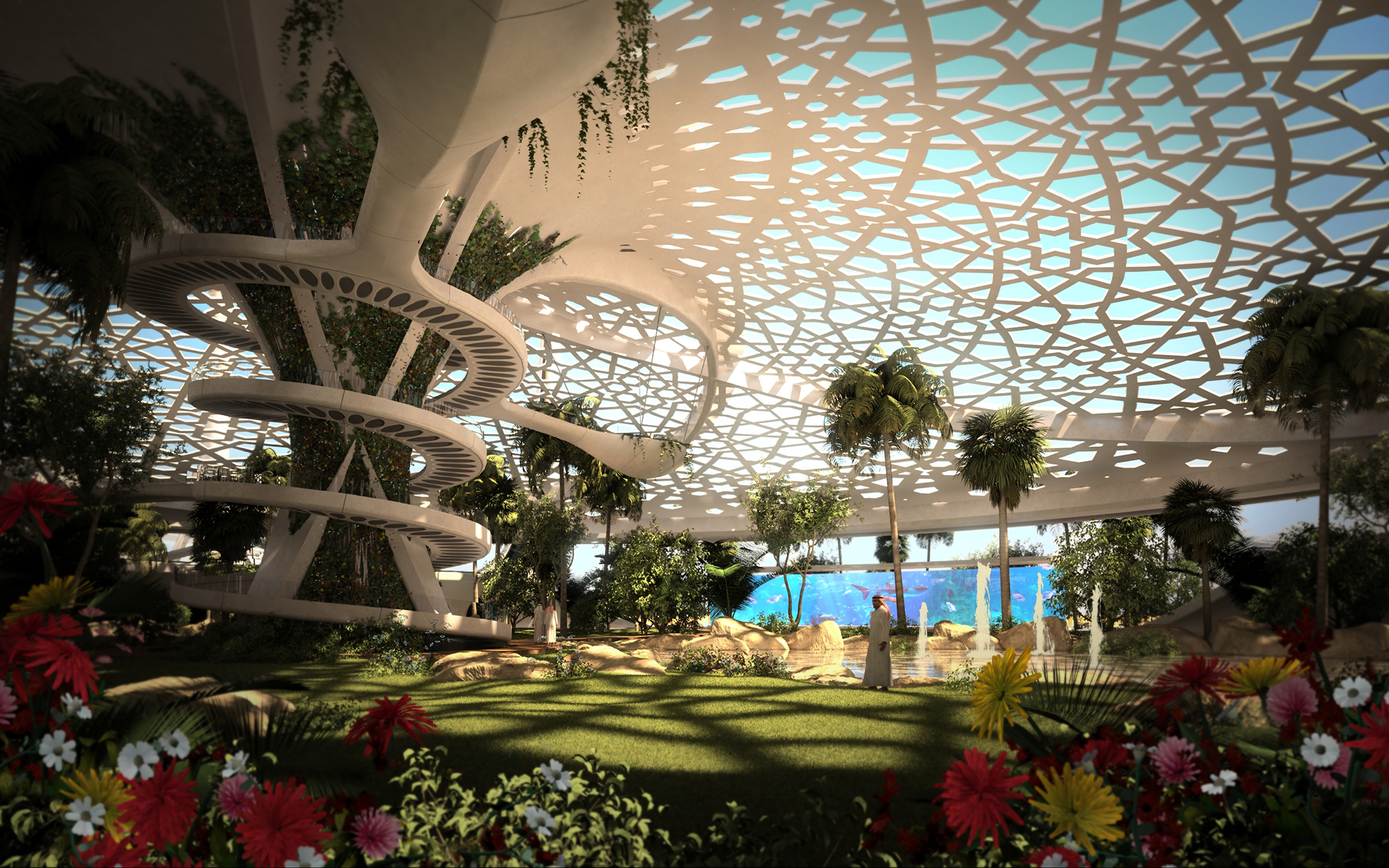
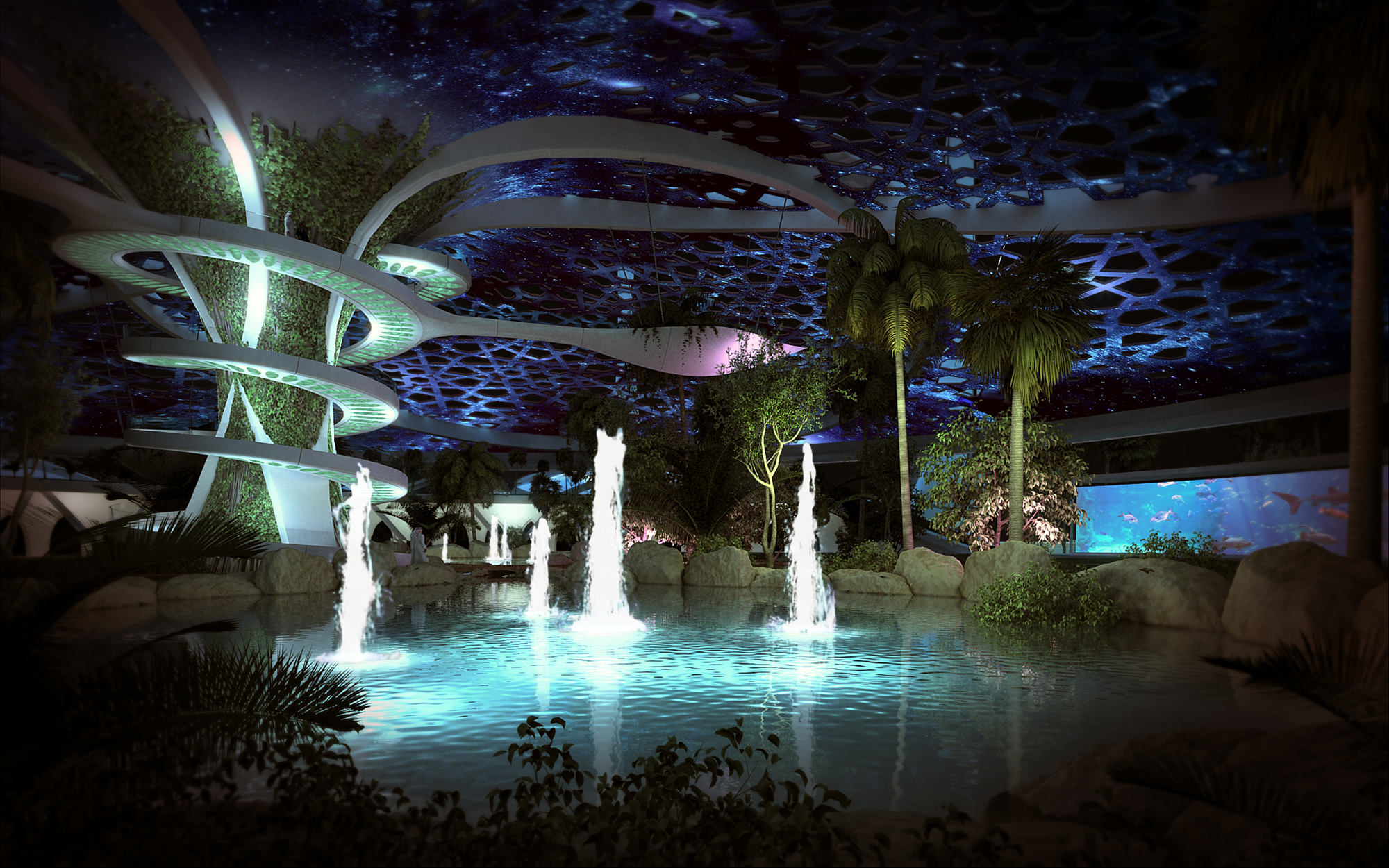
A Palace For Nature by sanzpont [arquitectura], Doha, Qatar
Ariel’s father’s palace in the animated movie was composed of imposing towers and organic forms. For the architectural enthusiasts watching the film, the underwater structure appears akin to the works of Antoni Gaudí.
sanzpont [arquitectura] created a similar fantasy above the ground as a competition entry; however, almost antithetical to the site of the underwater palace in the Little Mermaid, the Palace for Nature is imagined as a self-sustaining oasis in the middle of a desert. The design of the central dome is inspired by the native Sidra tree with a spiralling column anchoring it to the ground in the center. One can also see elements of Qatari architecture blended in with new-age parametric geometry. A micro-climate is created inside the structure with a mist irrigation system that uses water from the underground aquifer. Likewise, the outer skin of the dome and the roof contain photovoltaic panels to generate solar energy.
Sultan’s Palace from Aladdin
View this post on Instagram
A post shared by Aly Rogers (@aladdin_moments)
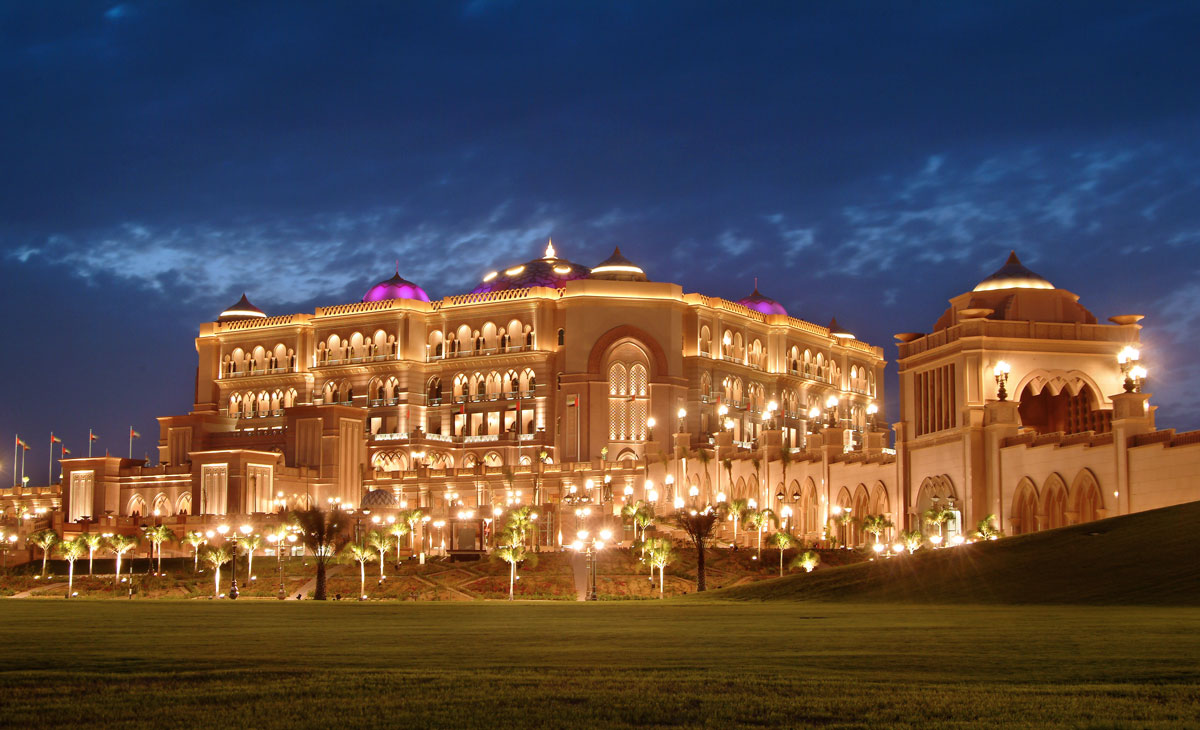
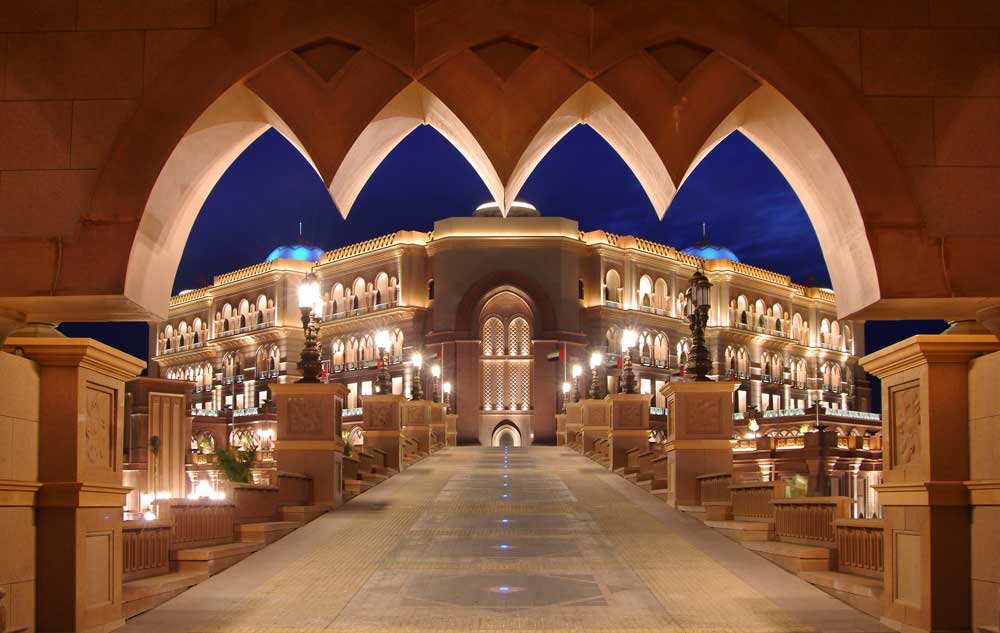
Emirates Palace by WATG and Wimberly Interiors, Abu Dhabi, United Arab Emirates
The home of Agrabah’s Sultan and his daughter Jasmine took inspiration from Indo-Islamic and Mughal architecture. Multiple minarets and exaggerated gilded domes speak of the wealth and prosperity of the Sultan.
The Emirates Palace makes a very similar statement of grandiosity. The brief was to create a large conference hotel that stayed true to the style and traditions of Abu Dhabi. Following those guidelines, the grand edifice is built using marble, granite and stone along with self-cleaning coated glass in balconies and spandrels. The firm also uses casting and etching methods to carve traditional motifs and patterns.
Architects: Want to have your project featured? Showcase your work through Architizer and sign up for our inspirational newsletter.
The post Animating Life: 9 Real-World Buildings Designed Like Disney Movie Sets appeared first on Journal.
Did you miss our previous article…
https://thrivingvancouver.com/?p=1058
Invisible Dwelling // onSITE
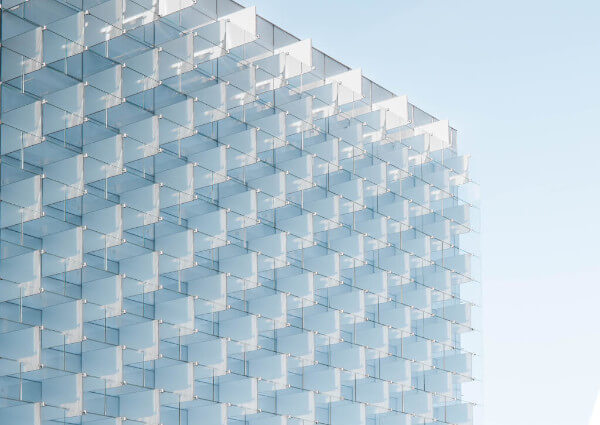
Project Status: ConceptSize: 0 sqft – 1000 sqft
Text description provided by the architects.
60 square meters is a small object but 15 square meters, 4 times, is an experience : a journey.The Journey begins at the entry to a tertiary wadi. In practical terms a head house provides shaded parking, fresh dates and other front-of-house services as well as back-of-house infrastructure. But in transcendental terms a head house creates a threshold : a preparation : a transformation.
© onSITE
Here, you leave all the trappings of contemporary life (cars, computers, cell phones, electric appliances, luggage, money, time pieces, etc). you shower, you change into an uniquely coutured kaftan and you ascend a wadi-wide monumental stair. This is not the entry to a building but rather the entry to a life experience.
© onSITE
The majesty of the landscape invites you to wander, to explore : the way that travelers through this place have for thousands of years. History reminds you that this is a place of shared cultural heritage. There is something universal here. As you explore you discover both sanctuary and prospect.
© onSITE
To know this place you cannot simply visit it, you must live it.In the words of Ibn Battuta “He who enters is lost; he who leaves is born.”The project resists the urge to build on the highest, the most beautiful, the most visible or the most interesting parts of the landscape and instead seeks to preserves the pristine natural beauty of those places.The site is not specific in its location but rather specific in its quality.
© onSITE
The tertiary wadis are higher and thus limited in the severity of flood danger but also, as local camel farmers demonstrate, their single or double entry points facilitate isolation and preservation. Built elements are nestled within the high ground in the inlets which feed the wadi. Here, they are above the floodway and back from rock fall.
© onSITE
These pockets are secluded places of extreme tranquility, sheltered from the wind, and silenced by the surrounding cliff walls. Here, 5 single room, single aperture instruments take place. Each born of the materials of the place. Each a rough, weathered geolith – armored from the harsh desert – shielding a carefully oriented and tuned, immersive sensual experience of a primary terrestrial element: earth, water, fire, void and sky.
The spaces are not “programmed” in the conventional contemporary sense, neither are they furnished nor decorated.
© onSITE
Rather they are “programmable”. This is to say that while the fire room is in no way a “kitchen” all the resources for food storage and preparation reside in this space. Formally, the fire room is the tallest of the elements it is an inhabitable chimney. You enter it through a tall, narrow slot, guided by a slice of light washing a wall of meticulously hand textured earthen plaster.
© onSITE
The texture both catches the light of the flickering fire and holds the aroma of charred timber. The crackling kindling is enhanced by the dense mineral surfaces. Here, the intentional suppression of the expected heightens your consciousness of the subtle, of the fundamental : this is luxury.In this arid place, water is among the most precious of commodities.
© onSITE
To survive here literally requires the mastery of hydrology. And so the vestiges cultures who have thrived on this land include brilliant examples of hydraulic infrastructure. Harvesting water in the generic sense is insufficient. The water room is thus calibrated to this equilibrium: The saltwater bath is therapeutic, the steamy hot water shower is sanitary, the cold fresh water quenches thirst, the gray water evacuates waste and the black water nourishes plantings.
Like descending into a well, the entry to the water room is a long shallow stair.
© onSITE
The entry corridor leads you onto a promontory surrounded by a pool in the center of a dome, under a single oculus. You shower in an ether of steam and light. You soak in a suspension of water and salts.Here, the intentional augmentation of the arbitrary enriches your experience of the habitual, of the necessary : this is luxury.The Nabateen were expert stone masons.
© onSITE
Their habitations for eternity : their tombs for the dead, were carved into the live rock. Their temporal habitations : their villages for the living, were erected from rubble masonry. This experience aspires to be both : timeless and light on the land. It’s structural and constructive systems emerge directly from material and constructive cultures of the place while simultaneously writing the next chapter of this shared language : digitally carved complex stone geometries, simply assembled with traditional earth mortar masonry technologies.
The earth room is entered obliquely from a bent corridor.
© onSITE
The space is initially withheld from your view. As you round the corner you remain on-grade with the adjacent land and find yourself oriented toward a naturally placed boulder. You are offered a view but the focal length is short and aperture is low. You are encouraged to approach the floor.
© onSITE
From this vantage you appreciate a textile ground-scape. While hand rendered earthen plaster has created the atmosphere, now felted wool fiber delivers intimacy. You kneel, you sit, you lay.
Here, your visual perceptions are intentionally limited to provoke your tactile perceptions, to draw you close to the earth, to rest your body : this is luxury.
At a time when globalization has drawn many people to urban centers and has diluted experience to ephemeral images – iconic non-experiences which can be captured and shared on social media, which belong to everywhere and nowhere and which fade as quickly as they rise all proport authenticity.
© onSITE
This place is about focus and memory.You enter the void room by climbing a stair. Your vantage is high, your view is long. The room is dead silent. A felted textile envelope, like a Bedouin tent absorbs visual and auditable noise. You observe the landscape but you are removed from the experience of it.
© onSITE
A central stone monolith is a place to sit, a place to write, a place to eat, a place to read.Here, the emptiness is intentional, the abstraction is real, this place is a blank canvas : this is luxury.The sky room is a boundless observatory on the stone ridge. It is accessed first by a stair carved directly into the live rock face following the natural contours, than through a vault-like enclosure and up a spiral stair to a honed stone platform.
By the time you arrive the land is becoming dark and the sky is vibrant. The only tool you need is the telescope that you discover on the axis of the stair. As you situate yourself in the cosmos night turns into dawn.Here time bends and disappears, infinity becomes measurable : this is luxury.A great teacher once said that “architecture is the marriage of art and engineering”.
From their intricately carved monolithic necropolis freed from the live sandstone outcrops to their patiently hand fashioned rubble and clay metropolis born of the earth, few civilizations -ancient or contemporary- have demonstrated this foundational relationship between creativity and ingenuity more fully than the Nabatean. To this end, the collaborative underpinning of our team is a mutual reverence for disciplinary expertise.
This is to say that we have assembled a team of architects, material scientists, landscape designers, exhibition designers, an earth plaster sculptor and a textile artist, all of whom offer specific disciplinary expertise but all with shared professional experiences, shared values and a shared investment in conceiving and realizing a coherent collaborative work of architecture: a work of engineering to which the art is indissociable and a work of art to which the engineering is indissociable.
The ambition of our team is that cultural project is equally as important as the architectural project.
This is to say that the collaborative making of the architecture is as important as the physical manifestation. As with all of our projects, a series of exhibitions, publications and training workshops will ensure that the material and human resources developed for the project transition into sustainable contributions to local culture and economy.
With the long history of domestication of sheep, goats, and camels in the Arabian Peninsula, these animals’ fibers have been used in producing various textiles and materials for clothing and shelter in the region.
An abundant natural resource, animal fibers are highly suitable for the climate in both hot and cold temperatures. Many elements of the traditional Bedouin home such as the exterior and interior walls, floors, roofs, and various furniture (mattresses, cushions, and rugs) are some form of a textile, woven using a simple floor loom.
This Bedouin loom has remained a primitive tool, which can produce very intricate weavings. The essence of this loom is preserved while exploring the evolution of this simple technology to create complex textiles which can become three-dimensional and spatial. The textile becomes ‘inhabitable space’. Sheep’s wool is an abundant and versatile fiber.
It can be used in various forms, from loose fiber for stuffing mattresses and blankets, to spun yarn for weaving into various textiles for garments, interiors, and exteriors. Wool can also be ‘molded’ through felting, which transforms the loose fibers into textiles and objects. Felting is synonymous with ancient Nabatean building processes where mountains are carved to create spaces within, producing loose rubble, which is then assembled into built structures for living.
The loose wool is sheared off the sheep’s body and then reassembled into two and three-dimensional forms – ‘inhabitable works of Art’. To be invisible means to be immersed the history of a place, to be in harmony with the spirit of a place. To be invisible means to resist the global and the virtual in favor of the local and the real, to be built from local materials rather than from imported products, to be simultaneously high-tech and low-tech, to be experiential rather than iconic, to improve rather than to degrade with age, and to enrich rather than to exploit culture.
To be invisible means to be monumentally modest: an architecture confident enough in the power of its experience to fade quietly into its setting. This is luxury..
The post Invisible Dwelling // onSITE appeared first on Journal.
Did you miss our previous article…
https://thrivingvancouver.com/?p=1055
DRIFTWOOD HUT PROJECT // Ryuichi Ashizawa +Hirokazu Toki + The University of Shiga Prefecture Ashizawa laboratory
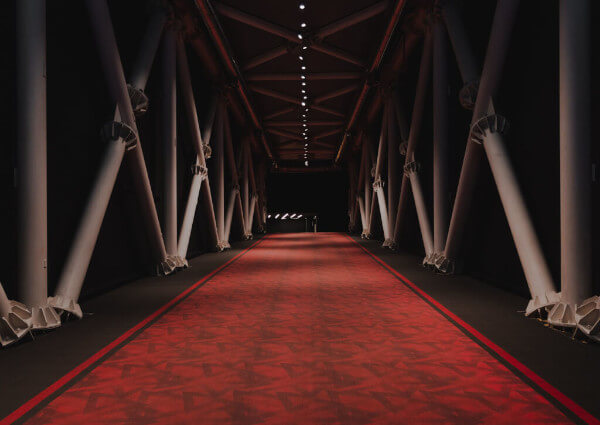
Project Status: BuiltYear: 2019Size: 0 sqft – 1000 sqftBudget: 100K – 500K
Text description provided by the architects.
In recent years, due to the effects of climate change such as heavy rains and sediment disasters, a large amount of driftwood has drifted onto beaches, rivers and lakes. The town of Okishima, a fisherman’s town and the inhabited island of only one Freshwater Lake in Lake Biwa, has a similar problem, and the local government pays for the collection and disposal of driftwood.
© Ryuichi Ashizawa +Hirokazu Toki + The University of Shiga Prefecture Ashizawa laboratory
In the remote island of Okishima, materials are transported by boat during construction, which requires more time and money than on the mainland. In addition, the waste generated on the island is basically not disposed of on the island, but must be transported off the island, which is equally time consuming and expensive.
© Ryuichi Ashizawa +Hirokazu Toki + The University of Shiga Prefecture Ashizawa laboratory
So, using driftwood drifted off the island and unneeded items such as fishing gear from the islanders, he built a resting place on the island. Each time he collected driftwood that had drifted off the shore of the lake, he proceeded with the construction, and with the cooperation of the islanders, he built the building through a student-led workshop.
All of the driftwood is different in shape, with a mixture of hardwoods and softwoods and varying properties.
© Ryuichi Ashizawa +Hirokazu Toki + The University of Shiga Prefecture Ashizawa laboratory
The shape, species, and structural strength of the collected driftwood were examined, and the method of constructing the building was explored by placing the varying driftwood materials in the right places. The model, 3D modeling, structural analysis, etc. were examined at the same time to see what kind of shape would be best.
© Ryuichi Ashizawa +Hirokazu Toki + The University of Shiga Prefecture Ashizawa laboratory
As a result, we left the circular nature in the center and led the dome space by the reciprocal structure that spreads radially from there. No hardware is used at all to join the driftwood together, but rather the fishermen’s technique is applied and it is tied together with a hemp rope in a box.
© Ryuichi Ashizawa +Hirokazu Toki + The University of Shiga Prefecture Ashizawa laboratory
Fishing nets and shade nets were used for the roofing, and hemp rope was used for the flooring. In the future, they will continue to consider thatching some of the roofs with bamboo and reeds that grow on the island. It is a sustainable architecture that can be easily replaced if a part of the architecture decays.
Using materials from the island that people don’t need, he created a new place for people to belong.
© Ryuichi Ashizawa +Hirokazu Toki + The University of Shiga Prefecture Ashizawa laboratory
This project questions the nature of architecture, which aims to encourage the small circulation of resources on the island through human intervention..
© Ryuichi Ashizawa +Hirokazu Toki + The University of Shiga Prefecture Ashizawa laboratory
DRIFTWOOD HUT PROJECT Gallery
The post DRIFTWOOD HUT PROJECT // Ryuichi Ashizawa +Hirokazu Toki + The University of Shiga Prefecture Ashizawa laboratory appeared first on Journal.
Did you miss our previous article…
https://thrivingvancouver.com/?p=1052
Technical Details: An Architect’s Guide to Hidden Gutters and Building Corners
Emma Walshaw is the founder of First In Architecture and The Detail Library, and has written a number of books aiming to facilitate a better understanding of construction and detailing. Contributions by Aida Rodriguez-Vega, architect and researcher at the Detail Library.
It is becoming increasingly popular to create a solid building volume by using cladding materials for both the roof and the façades. When doing so, a key junction to consider is the eaves — that is, where the wall meets the roof. Traditionally this would have an overhang and gutters. To avoid the common look of visible gutters (as an addition to a building rather than a thought through design element), hidden gutters are becoming an integral part of architectural design. Hidden gutters, if detailed correctly, can be extremely functional.
When using cladding materials across the entire building, another important junction are the corners of the building. Depending on the material chosen, location, use of the building, a detail should be chosen which is robust, weather tight and frames the entire building. This article offers key insights into detailing hidden gutters and buildings corners in a variety of materials, including timber, zinc and tile.
Four Key Design Considerations When Detailing Hidden Gutters:
1. Roof Pitch
The angle at which the roof pitch is designed is key in deciding if a hidden gutter is suitable. Too steep and the rain can struggle to run off into gutters, too shallow and some materials may not help drain water into gutters.
2. Roof Drainage Calculation
The size and number of rainwater downpipes required will depend on a number of factors. It is key to undertake a rainwater calculation on your roof before designing hidden gutters. Most manufacturers provide this service. The calculation is based on the area of the roof, slope, materiality, location, safety factor and BS EN12056:2000 requirements amongst possible others.
With this information the flow rate of roof, diameter and frequency required for the outlets can be calculated.
3. What to Do With the Downpipe?
Once a hidden gutter has been detailed, there are three main was of detailing any downpipes required.
I. Adding a visible hopper and downpipe to the façade.
II. Integrating a downpipe into the cladding zone so that it is outside but not visible externally.
III. Integrating the downpipe internally.
4. Access to Downpipes
It is very important, especially in option 2 and 3 that the downpipe has suitable access for maintenance, including leaf clearing and possible leaks. For internal pipework, it is especially necessary to consider thermal bridging, sounds transfer and that more internal space will be used up with the boxing out of pipework.
Detailing Timber Corners
The most important design considerations when detailing timber corners is that there are enough support battens for the cladding, as well as leaving movement joints throughout the cladding and corners to allow for movement. Timber cladding should always have continuous ventilation gap behind to prevent moisture buildup.

There are a huge range of timber corner details that can either be bought pre-formed or cut to size on site. Additionally, other timber sections can be used such as solid timber corners, which create a more framed and robust edge.
Detailing Hidden Gutters in Timber Cladding
Due to the versatility of timber and ease of adaptability on site, timber cladding can be one of the easiest façades to use when integrating hidden gutters. Within timber cladding, downpipes can be designed externally and internally. It is also relatively easy to design downpipes into the cladding zone, just as making an area of timber cladding removable is an easy way to allow for maintenance of the down pipe.
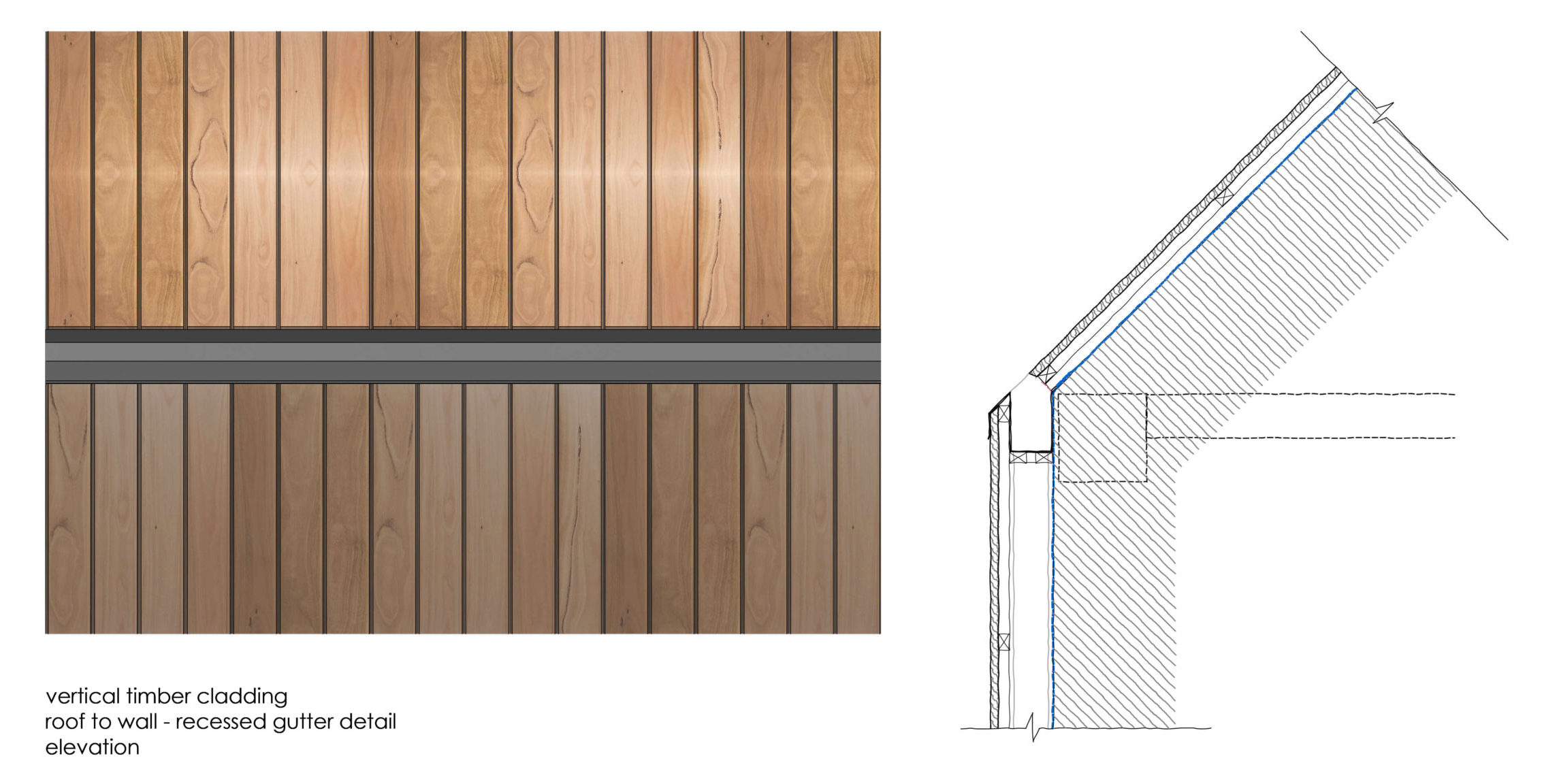
Depending on how much flashing you want visible and how robust you require the detail to be, there are a number of options when detailing timber cladding and hidden gutters. For a more robust option, a bespoke gutter can be installed with the suitable dimensions according to the drainage needed. This should have continuous flashing with a drip detail which drapes over the façade timber cladding. Breather membranes should always be draped into the gutter to allow for any water infiltration into the cavity to drain away from the building.
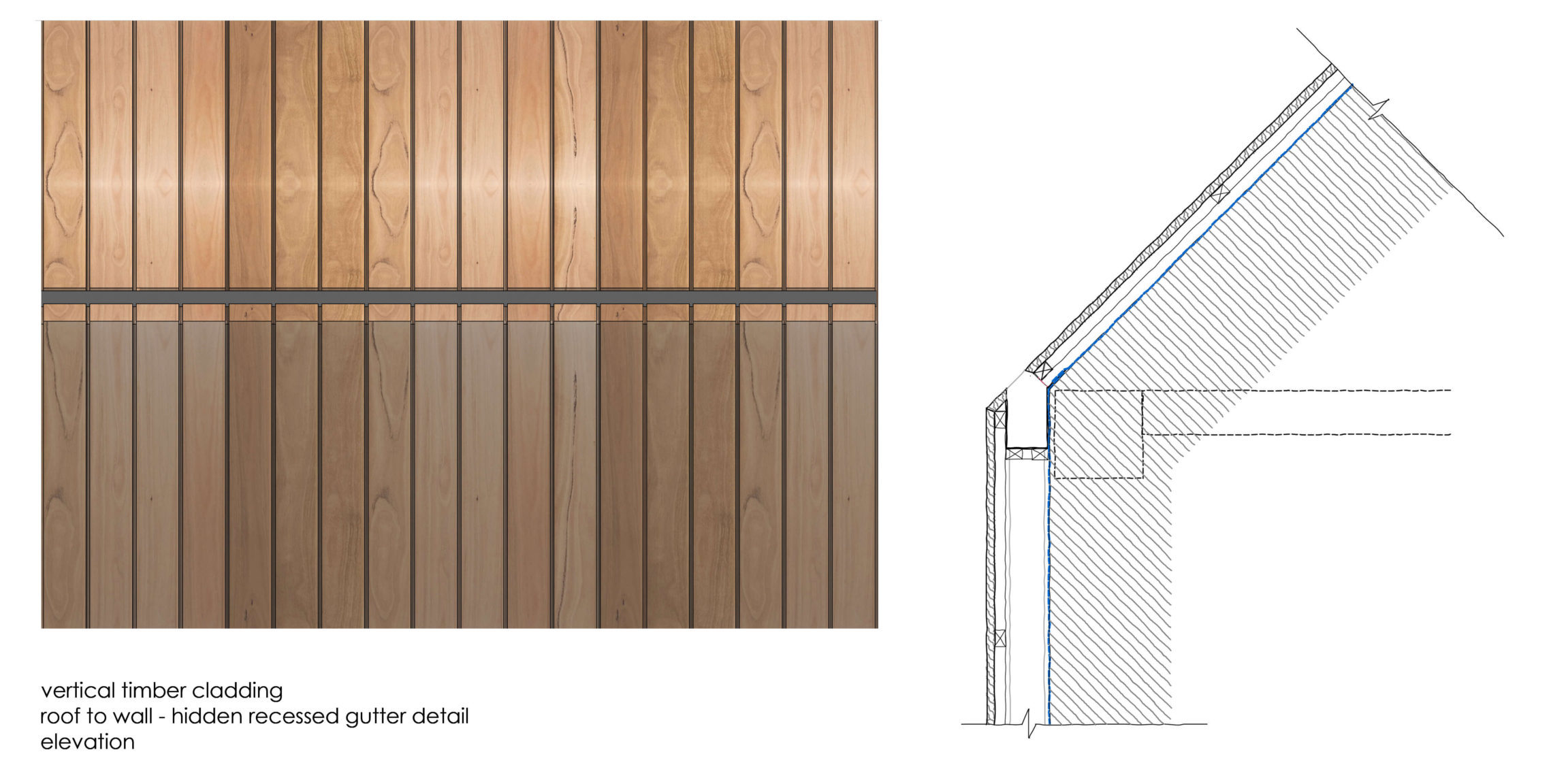
A less robust option is to clad timber over the gutter. The junction between the gutter and timber can be weak and it is therefore key to seal the junction in accordance with the roofing / cladding manufacturers’ recommendations.
Detailing Zinc Corners
When detailing vertical and horizontal standing seam zinc panels, there are a huge range of corner options to choose from. An important consideration when picking the corner design is the proximity to people passing.

If the corner is in an area of high foot traffic, it is desirable to have a folded option so that it is not affected by any knocks from people walking past. If the corner is away from where people have access, a more decorative option can be selected to enhance the edge of the building. It is also important to consider how this corner detail will work with the window surrounds and general standing seam details.
Detailing Hidden Gutters in Zinc Cladding
Most zinc manufacturers can provide generic details for hidden gutters and even calculate the roof drainage requirements. The width, depth and slope of gutters will vary from project to project depending on circumstance such as location and roof pitch.
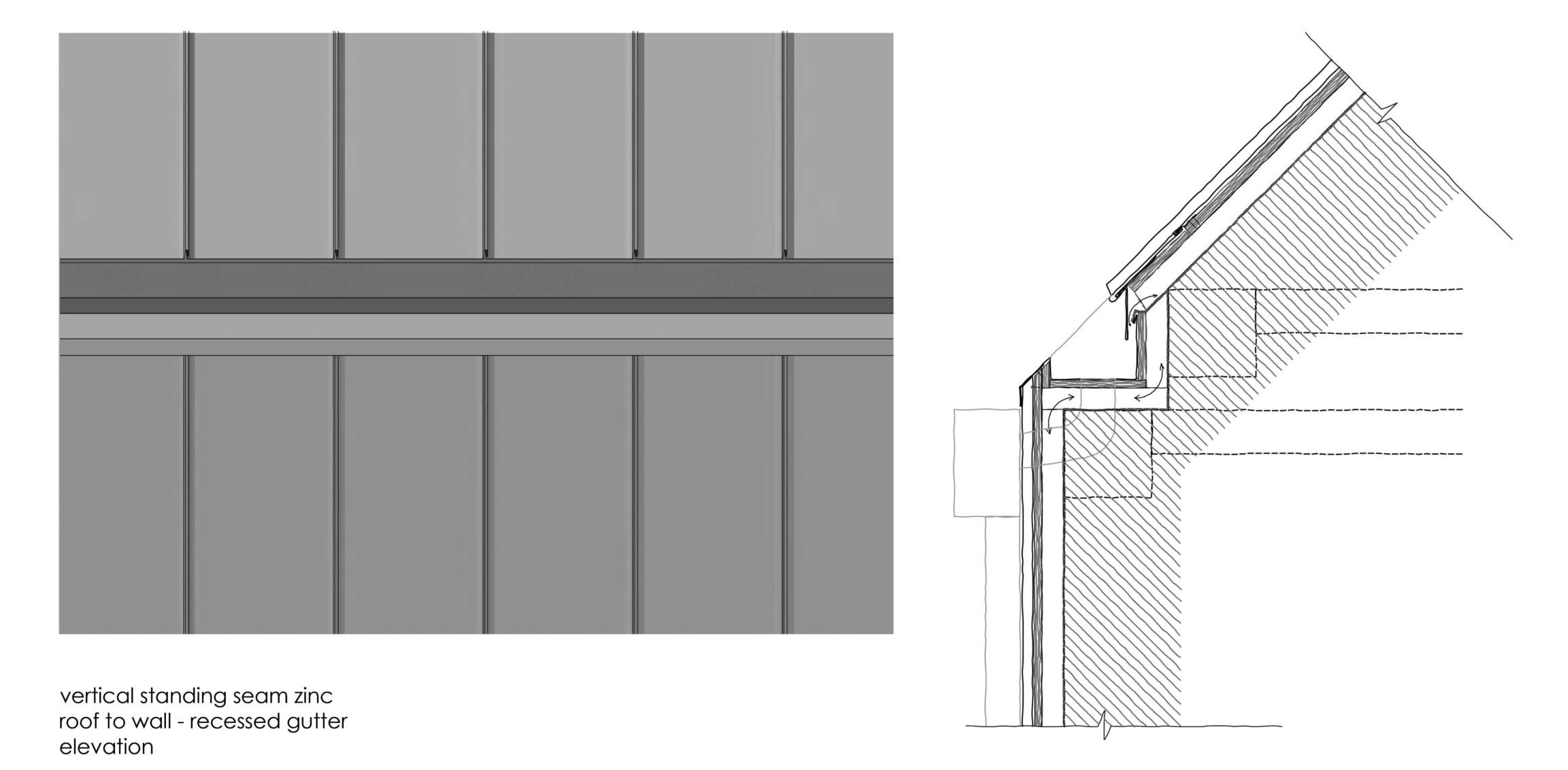
A key considerations when detailing zinc hidden gutters is maintaining the ventilation throughout — from the base of the cladding to the highest most point. Zinc cladding is normally built over a plywood base and requires ventilation behind. As the gutter and cladding are made from the same material, zinc creates excellent continuity between façade and roof.
Detailing Clay Tile Corners
If detailed correctly, corners to clay tiled buildings can be very elegant. There are a number of options for corners, including using a solid timber corner. Options such as bespoke corner tiles, or painted galvanized steel 45° and 90° angles are more popular options.

Galvanized steel can be factory painted to match the clay tiles and window surrounds and provide a robust corner to set out the tiles from and avoid the edges becoming damaged.
Detailing Hidden Gutters in Clay Tiled Cladding
It is harder to adapt clay tiles to hidden gutters due to the difficulty in cutting clay and need for flashing. There are a number of options when detailing clay tile cladding and hidden gutters depending on how much flashing you want visible and how robust you require the detail to be.
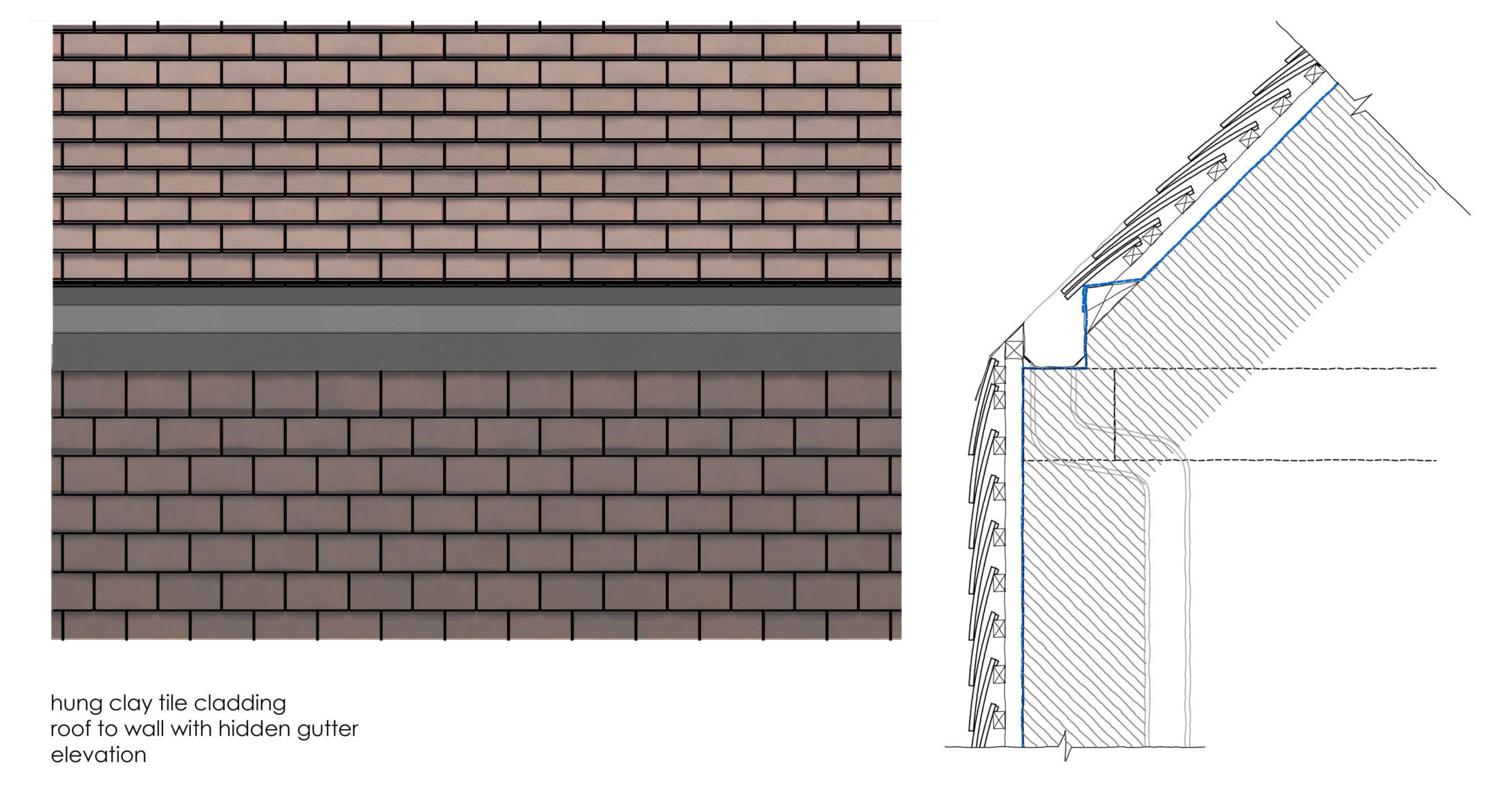
It is not recommended to take rainwater pipes internally due to the need for suitable thermal and sound insulation whilst creating access for regular maintenance. If this option is chosen, care must be taken so that pipes do not clash with structure whilst maintaining an adequate slope to allow water to drain properly.
Resources
If you want more inspiration on hidden gutters, styles and applications, be sure to follow Detail Library on Pinterest where we have hundreds of modern hidden gutters and rainwater, and roof ideas!
There are plenty of resources to help in choosing and how to detail hidden and visible gutters for each specific project. Below is a small selection of links.
https://detail-library.co.uk/september-2021-new-details/
https://www.dreadnought-tiles.co.uk/Vertical-Tiling-Details
Get your work published internationally this year through the 10th Annual A+Awards! The Final Entry Deadline is January 28, 2022. Click here to start your entry today.
The post Technical Details: An Architect’s Guide to Hidden Gutters and Building Corners appeared first on Journal.
Ribbon Dance Park : Landscape Placemaking for Public // TROP terrains + open space
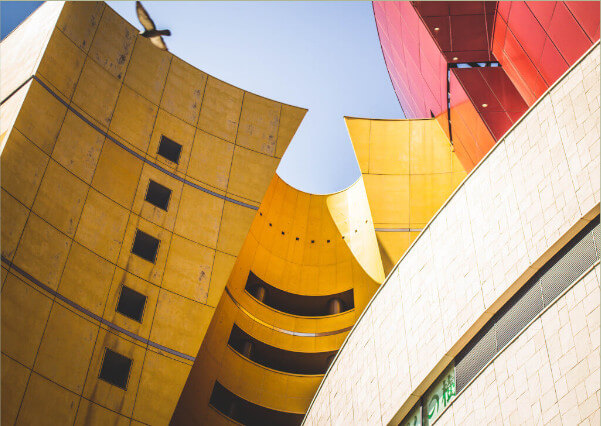
Project Status: BuiltYear: 2019Size: 100,000 sqft – 300,000 sqftBudget: Unknown
Text description provided by the architects.
Architects and developers are used to categorising their projects into one type; the type that only serves the clients’ goals and their programs, either being “public” or “private”. The client and the design team of the Grand Milestone Art Centre , however, defied this redundant habit and reimagined a private development beyond its boundary.
© TROP terrains + open space
© TROP terrains + open space
The result would successfully promote pedestrian accessibility for both the visitors and local communities. The project boasts a sophisticated landscape that showers every visitor with wonders throughout their journey into each space. Designed with utmost intricacy, every garden and courtyard displays themselves as a well-composed painting while acting as a living backdrop for any artwork exhibited.
© TROP terrains + open space
© TROP terrains + open space
However, these beautiful spaces would not be fully appreciated if people could not easily reach the site. Looking at the adjacent green corridor, the landscape team saw a great opportunity in creating the public “Ribbon Dance Park”, where a meandering ribbon-like boardwalk reconnects the existing but desolate footbridge with this new development and the city’s pavement network, enlivening the district once again..
© TROP terrains + open space
© TROP terrains + open space
Ribbon Dance Park : Landscape Placemaking for Public Gallery
The post Ribbon Dance Park : Landscape Placemaking for Public // TROP terrains + open space appeared first on Journal.
Siam Premium Outlets // Grimshaw Architects
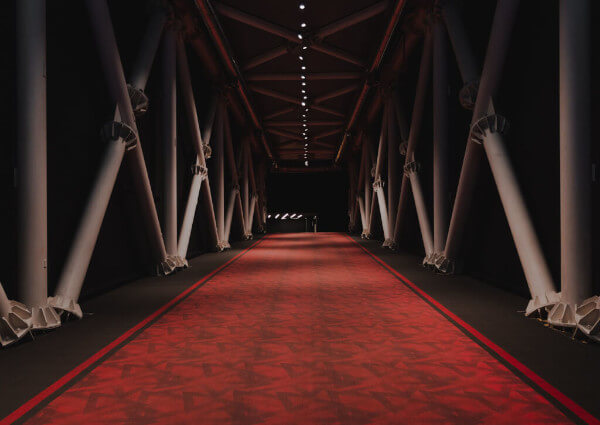
Project Status: BuiltYear: 2020Size: 500,000 sqft – 1,000,000 sqft
Text description provided by the architects.
Siam Premium Outlets, completed in 2020, is a luxury premium outlet that offers an experience beyond shopping with amenities and features that make the centre an exciting community space and a relaxing shopping destination.
The project is home to international and local brands and provides an ‘oasis’ serving locals and tourists and
features an array of dining, leisure, children’s playgrounds and installations by local artists.
© Grimshaw Architects
© Grimshaw Architects
No imported materialswere used and all construction labor was local. Rain is captured across the shopping podium and the surroundinglandscape into holding ponds for irrigating of the landscape. A series of sunken spaces along the promenadesbreak up the linearity and provide shade, including a feature amphitheater and a children’s playground, which hasproven to be popular with visitors.
© Grimshaw Architects
© Grimshaw Architects
Highly visible retail frontages create an open feel and the walking distances between feature attractions assist visitors with wayfinding and orientation. The many entries are highly visible, decorated with soft landscape and overhead artistic canopies with light diffusing membranes. Other features include large food hall concepts and locally inspired art installations on the promenades, themed around sustainability, occupying the generous promenades with an ability to update and change the works over time.
© Grimshaw Architects
© Grimshaw Architects
Siam Premium Outlets Bangkok will be an economic driver for the local community, and so far has provided more than 1000 employment opportunities..
© Grimshaw Architects
© Grimshaw Architects
Siam Premium Outlets Gallery
The post Siam Premium Outlets // Grimshaw Architects appeared first on Journal.
Did you miss our previous article…
https://thrivingvancouver.com/?p=1036
Structural Expressionism: Richard Rogers’ Design Theory Illustrated in 8 Projects
Get your work published internationally this year through the 10th Annual A+Awards! The Final Entry Deadline is January 28, 2022. Click here to start your entry today.
When one thinks about the works of Italian-born British architect Richard Rogers, the Pompidou Centre and Millennium Dome are some of the first structures that come to mind. Along with British architect Norman Foster, Rogers was well-known for the popularization of high-tech architecture – also known as structural expressionism. This style is best exemplified in Lloyd’s building, where the edifice’s structural and mechanical components were placed on the external surfaces instead of being hidden in the core.
Additionally, Rogers’ early ideas about sustainability and proposals for urban planning, where public spaces were a dominant feature, made him a popular name in the United Kingdom. For his revolutionary ideas and remarkable design, Rogers received several accolades like the RIBA gold medal, Praemium Imperiale, Pritzker Prize and the Minerva Medal before he retired from the firm Rogers Stirk Harbour + Partners (formerly called Richard Rogers Partnership) in 2020. Below are a selection of his firm’s less canonical works that showcase the late architect’s emblematic concepts and design details.
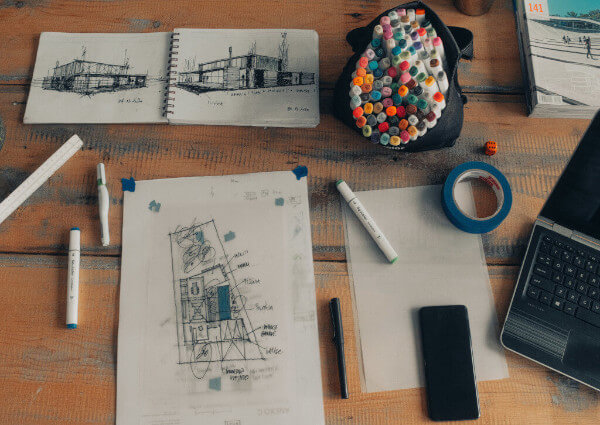
B&B Italia, Como, Italy
In the early 1970s, the young firm was asked to create a design with open-ended systems to assure flexibility. The solution was a streamlined structural framework comprising lightweight portal frames that were used to suspend a glazed office container. This system helps the interior remain column-free and partition-free with the services being placed in the peripheral areas.
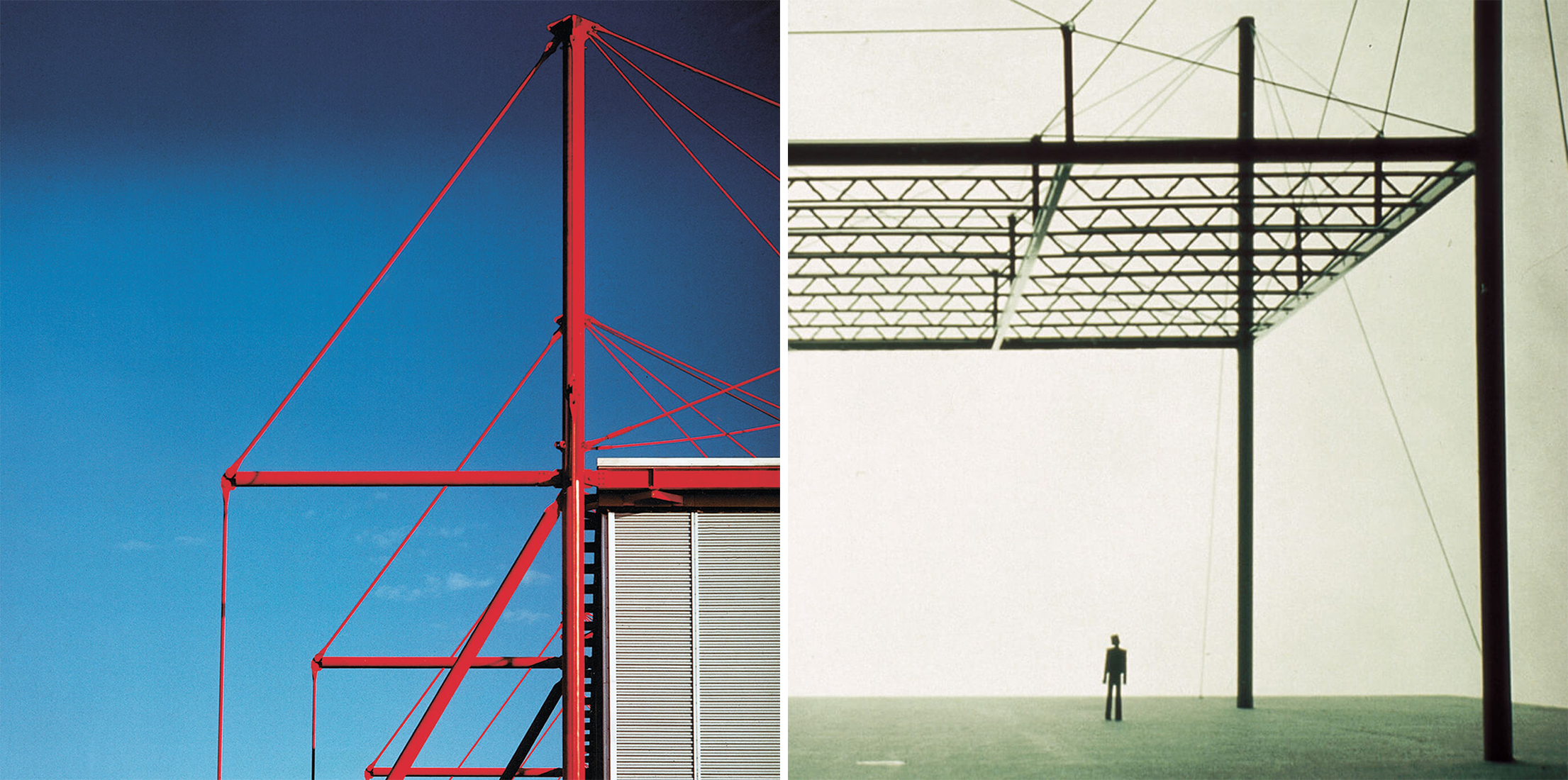
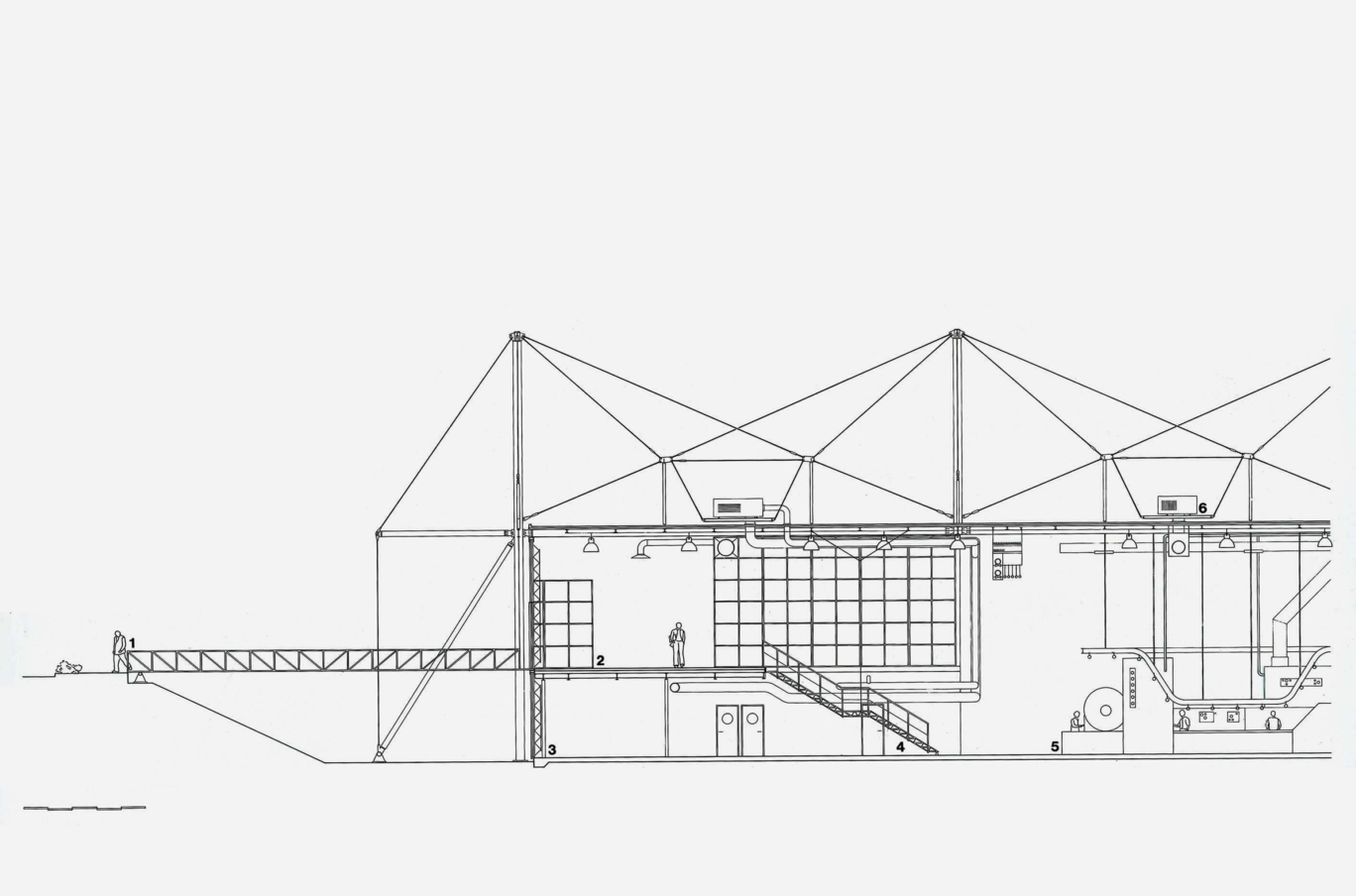
Fleetguard, Quimper, France
This 1981 project is a manufacturing plant for air, fuel and oil filters. Along with these production facilities, it also includes storage facilities and administrative offices. The design was created keeping in mind the potential growth in the future. One of the main focal points was a minimal intrusion on the surrounding landscape, which was achieved by using excavated soil to create a landscaping scheme that segregated industrial and regular traffic.
The main structure is formed using a suspension system of prefabricated elements to reduce roof span and structural depth. This allows the easy addition of functions without disrupting the ongoing work in the building. The emerging firm’s design won a couple of awards including the Premier Award for Exceptional Steel Structure, France and the Constructa-Preis for Overall Excellence in the Field of Architecture.
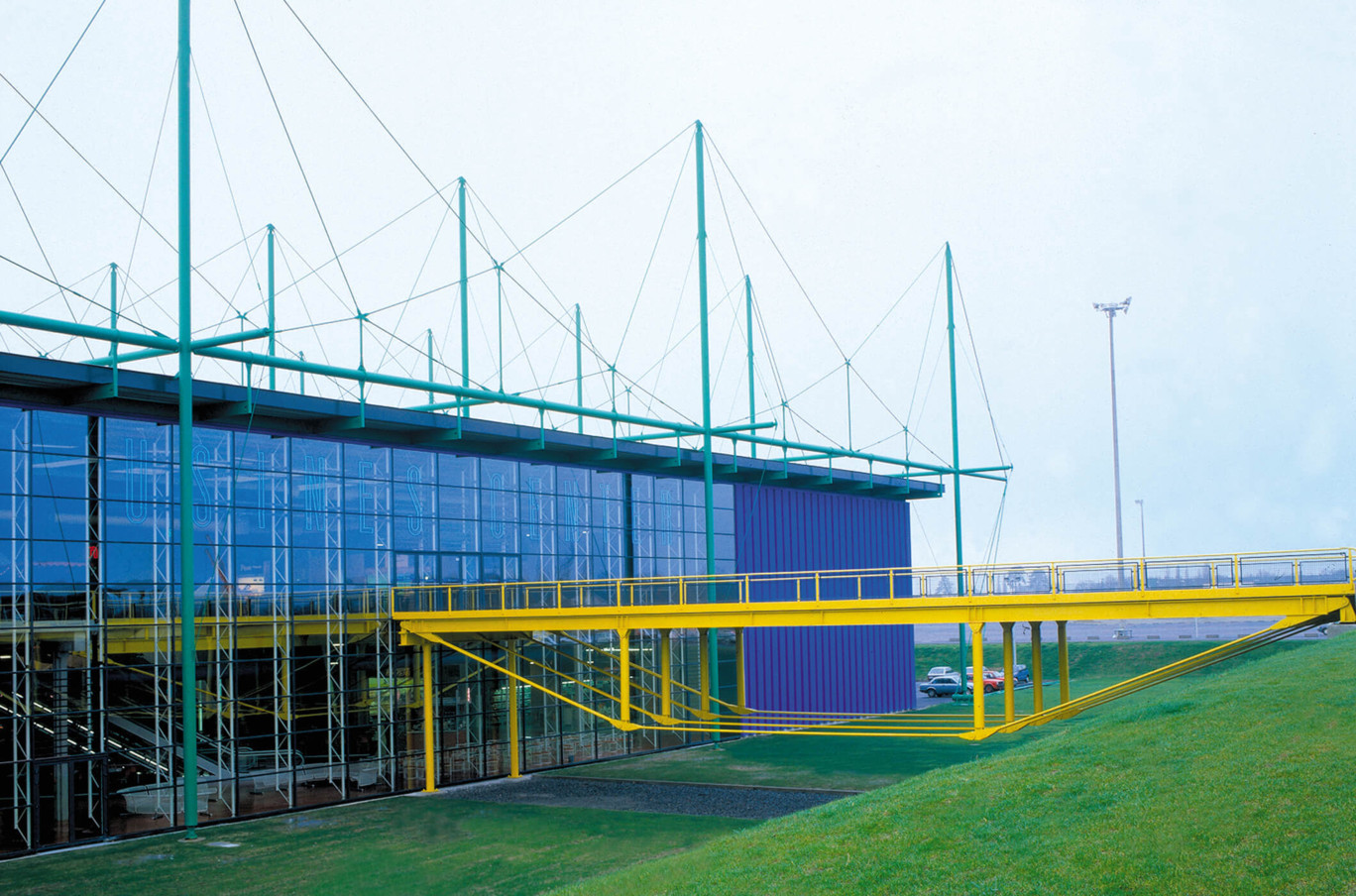
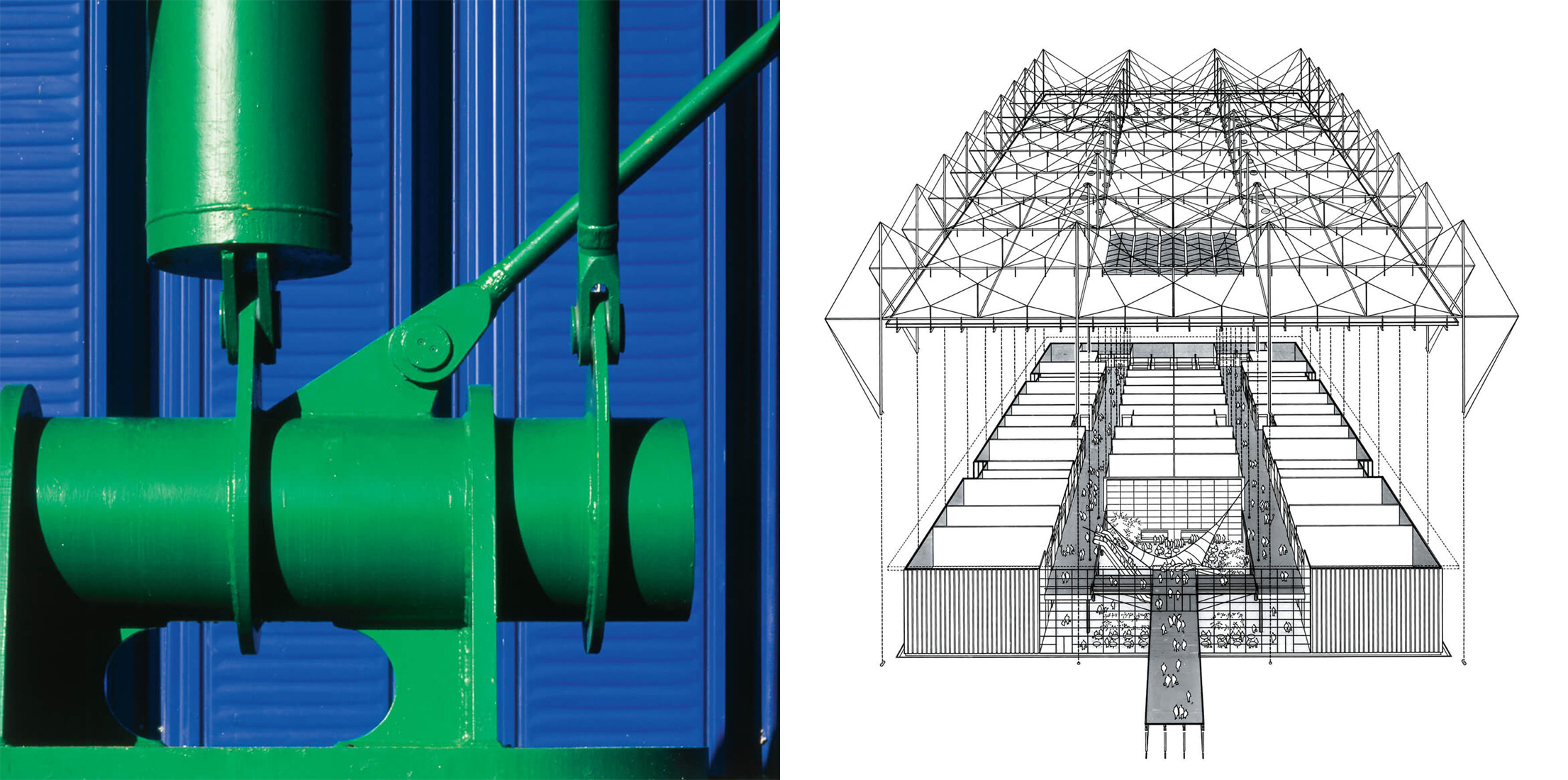
Centre Commercial St Herblain, Nantes, France
Less than a decade after completing the Fleetguard factory, Rogers’ firm undertook the design of a low-cost shopping center featuring a suspended system with bright turquoise masts in 1987. A metal bridge, painted in a vibrant yellow, guides users to a double-height reception area. All the structural elements outside and services within have been kept exposed to give the building more character. The interior is organized similar to a regular mall, with stores placed on two sides and in a row in the center.
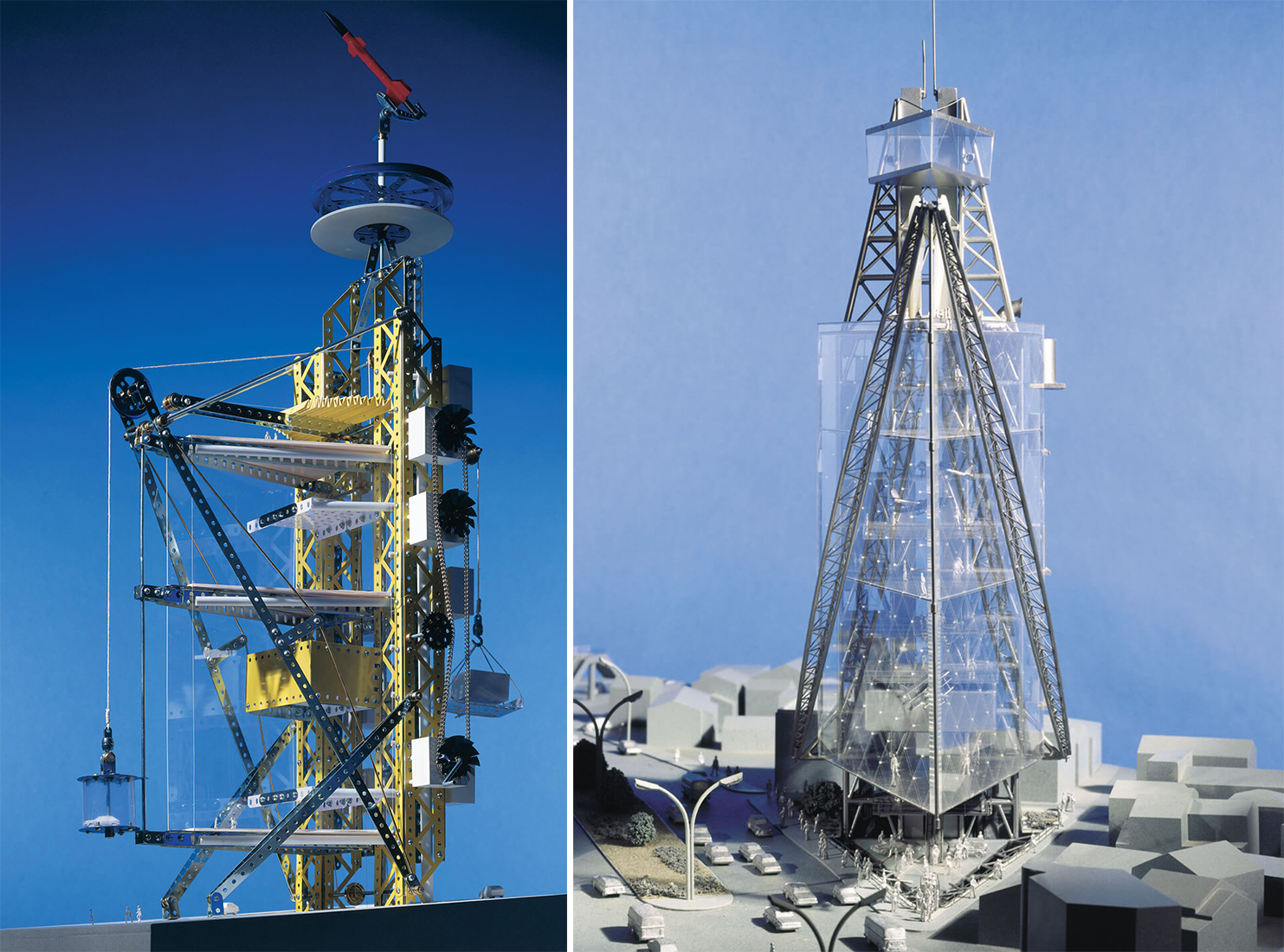
Tomigaya, Tokyo, Japan
Built during the property boom in Tokyo in the 1980s, Tomigaya is a structure on a small triangular site surrounded by low-rise buildings, a highway and a park. Due to certain floor and height constraints, the proposal uses transparency to create vertical exhibition spaces that are visible from the highway. Additionally, two steel trusses on one side of the triangle hold up a large crane that can be used to change floor heights to accommodate different exhibits.
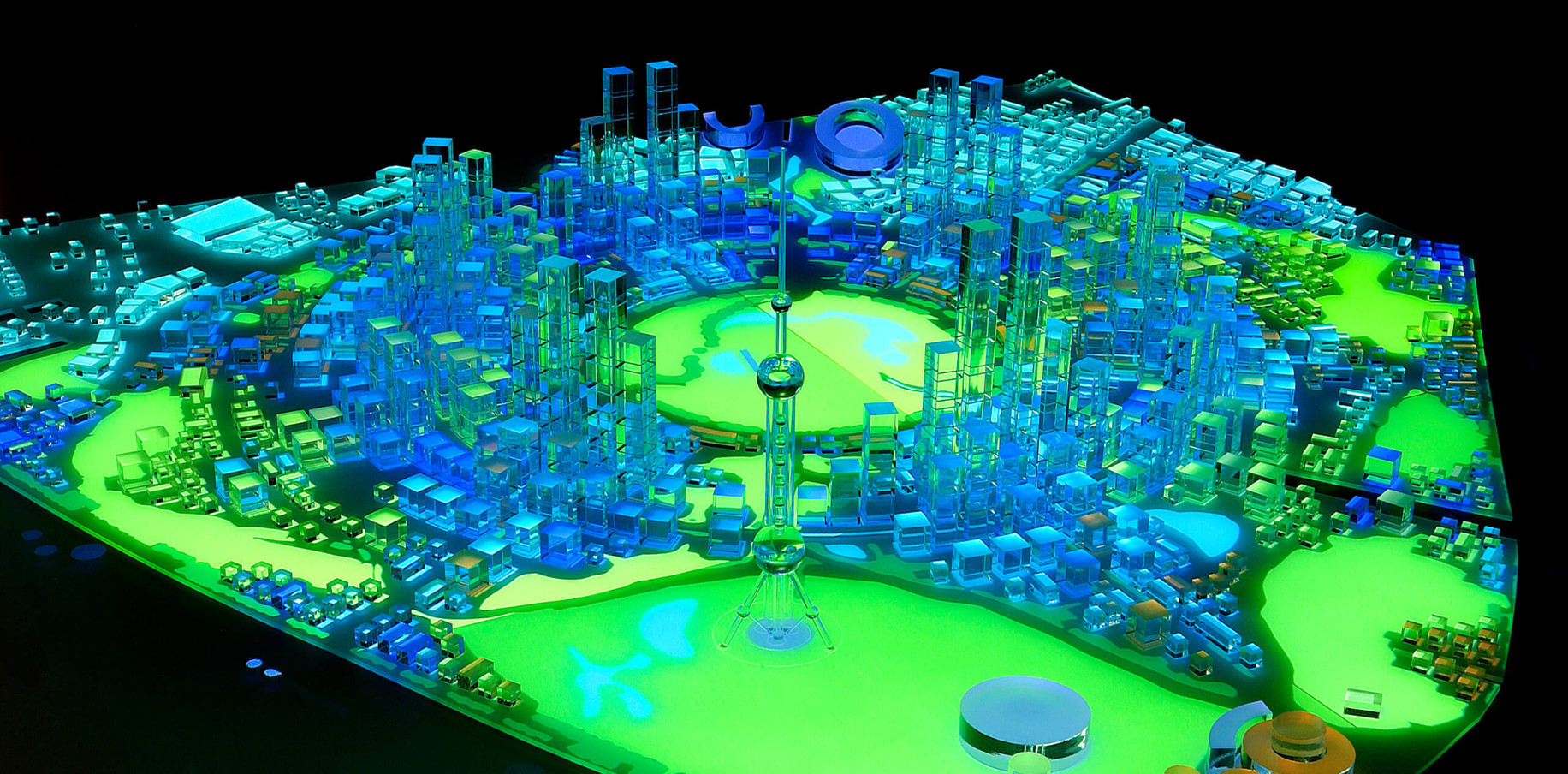
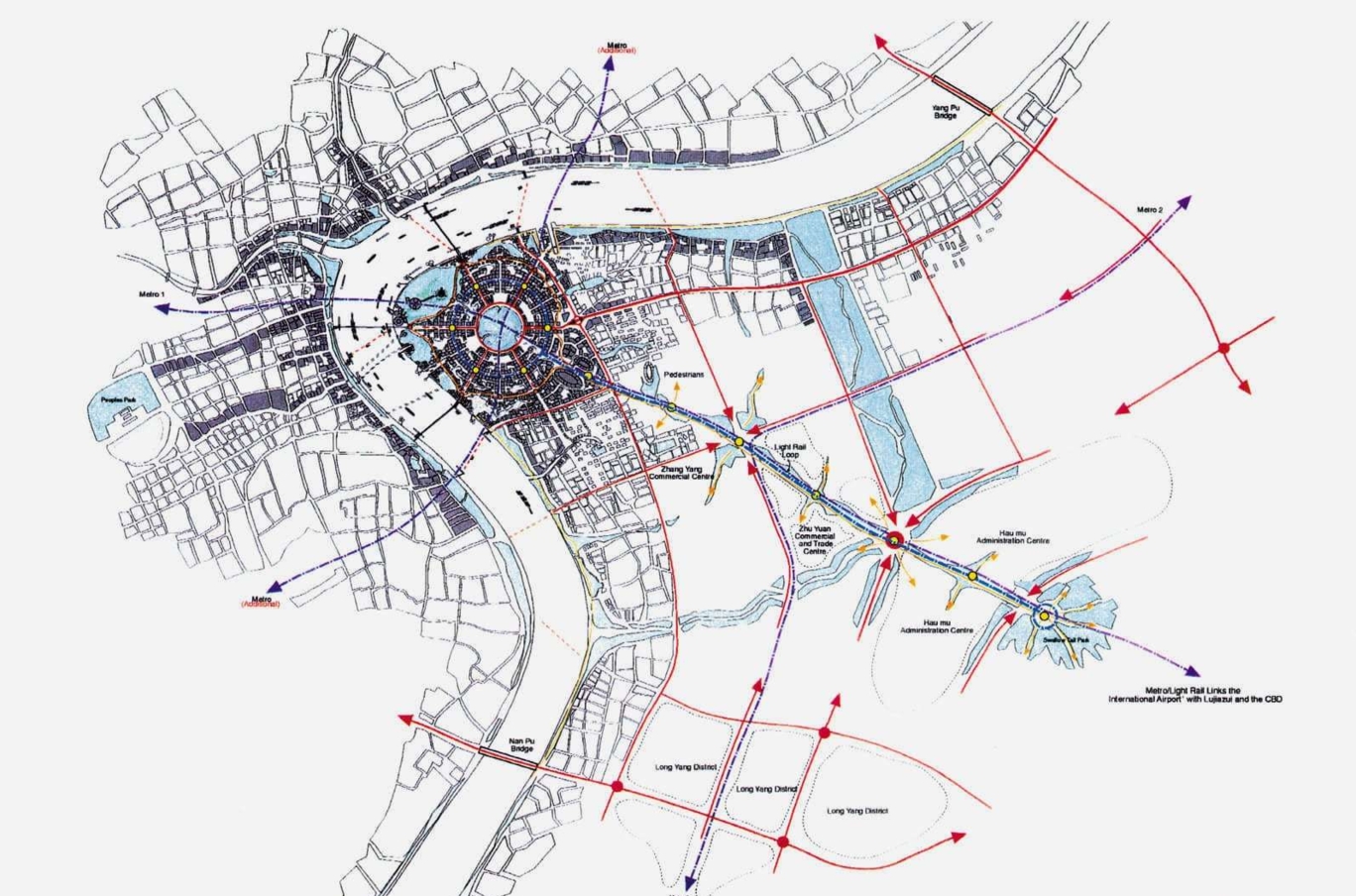
Shanghai Masterplan, Shanghai, China
Well known for his theories on urban design, Rogers also conceptualized several masterplans for cities across the world. When Pudong was identified as the new financial district in the early 1990s, shipyards and industries occupying the area were removed. This proposal for redevelopment is a residential and commercial area that is tied together with several parks and public spaces. The plan uses a circular core with a park at its center and boulevards forming concentric rings around it. These rings are separated and divided into segments by public transport routes and nodes. This results in easy access and better connectivity.
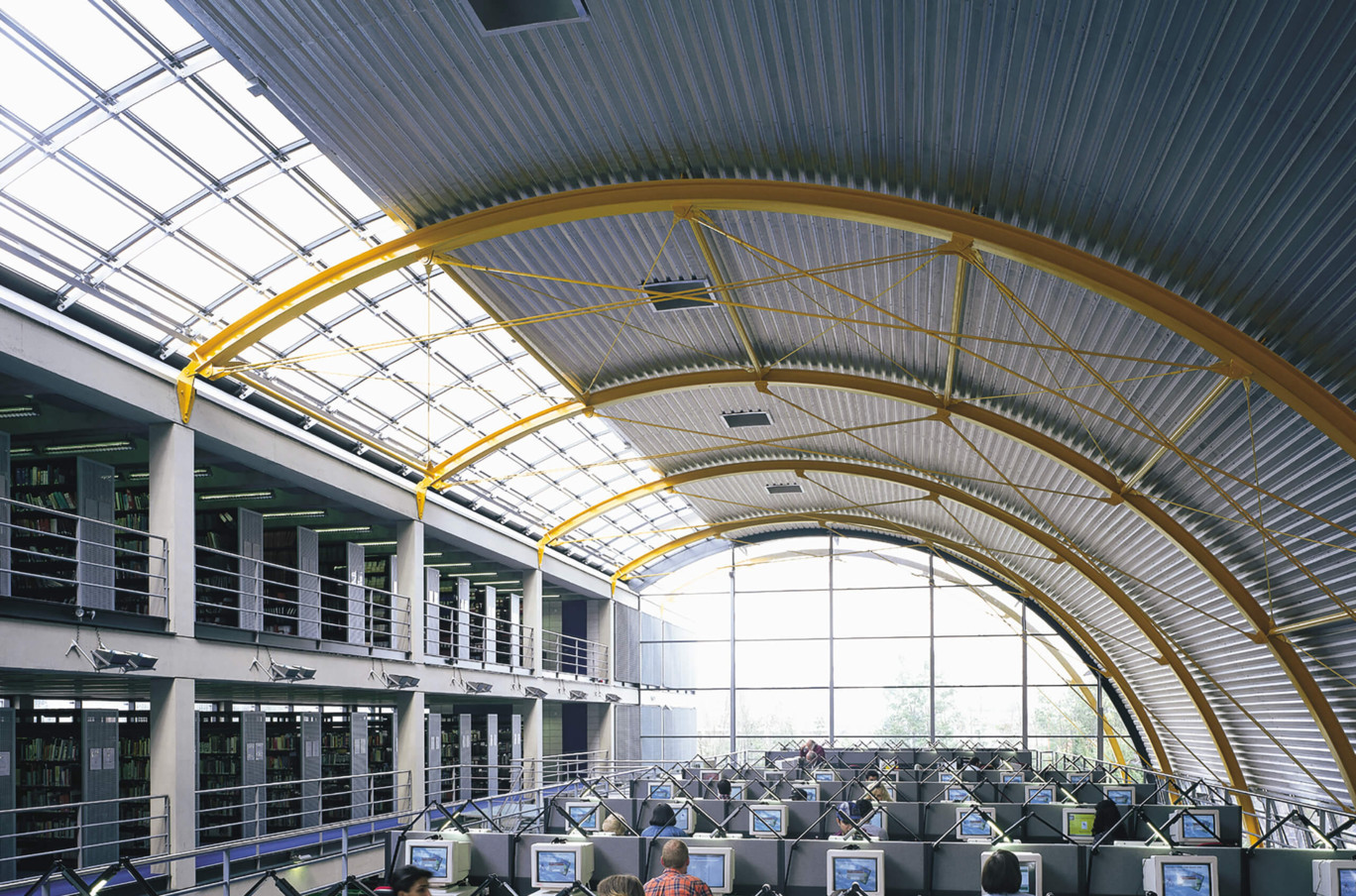
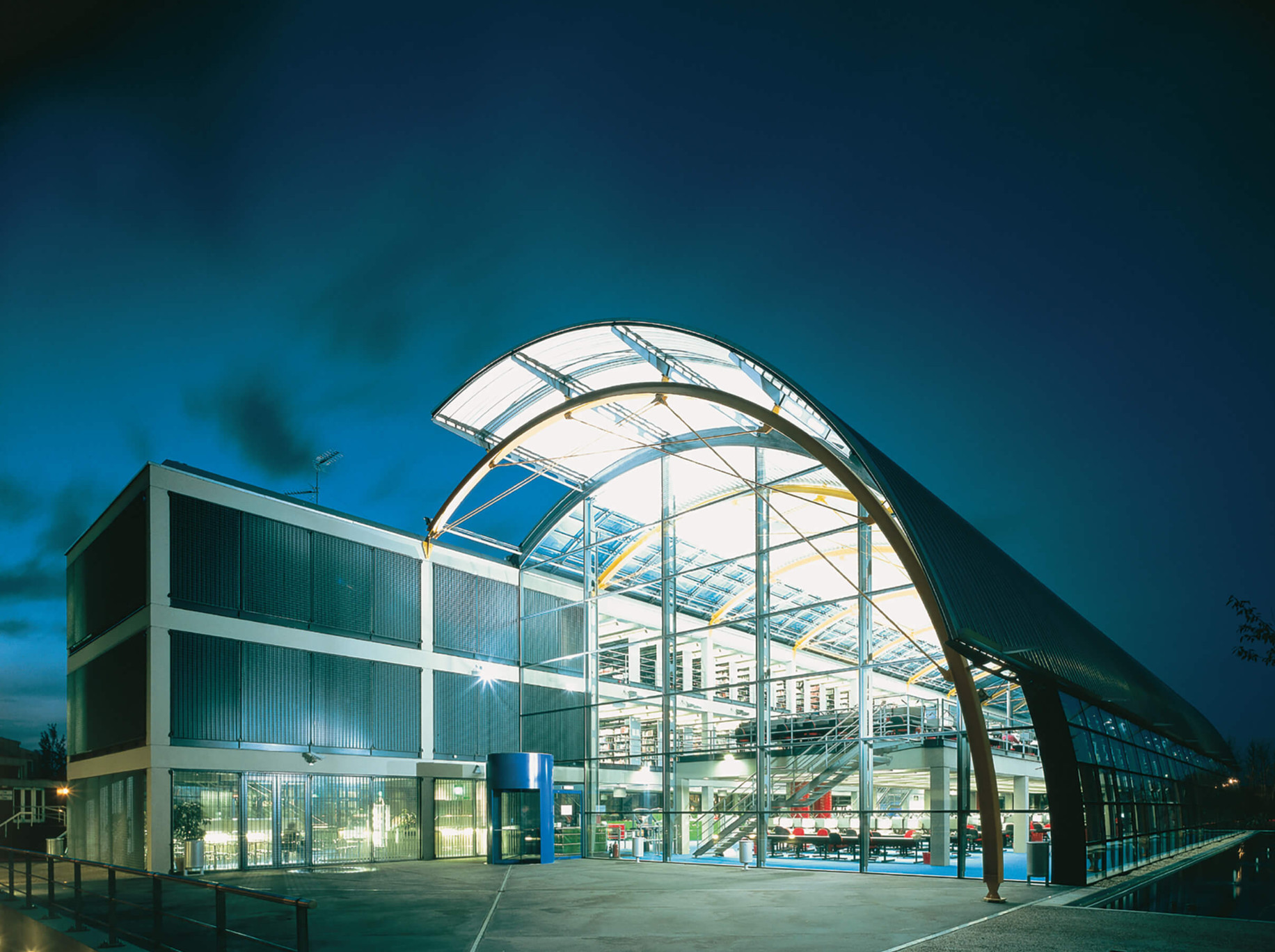
Thames Valley University, Slough, UK
What makes this iconic 1996 structure very recognizable is the large covered dome that is connected to a rectangular block. It is equipped with internal motorized fabric blinds for solar control and is also designed to collect rainwater. The facility contains spaces for books, CDs, laptops, open working areas and seminar rooms. To ensure connectivity with the landscape outside, this curved surface also has a large opening at the base.
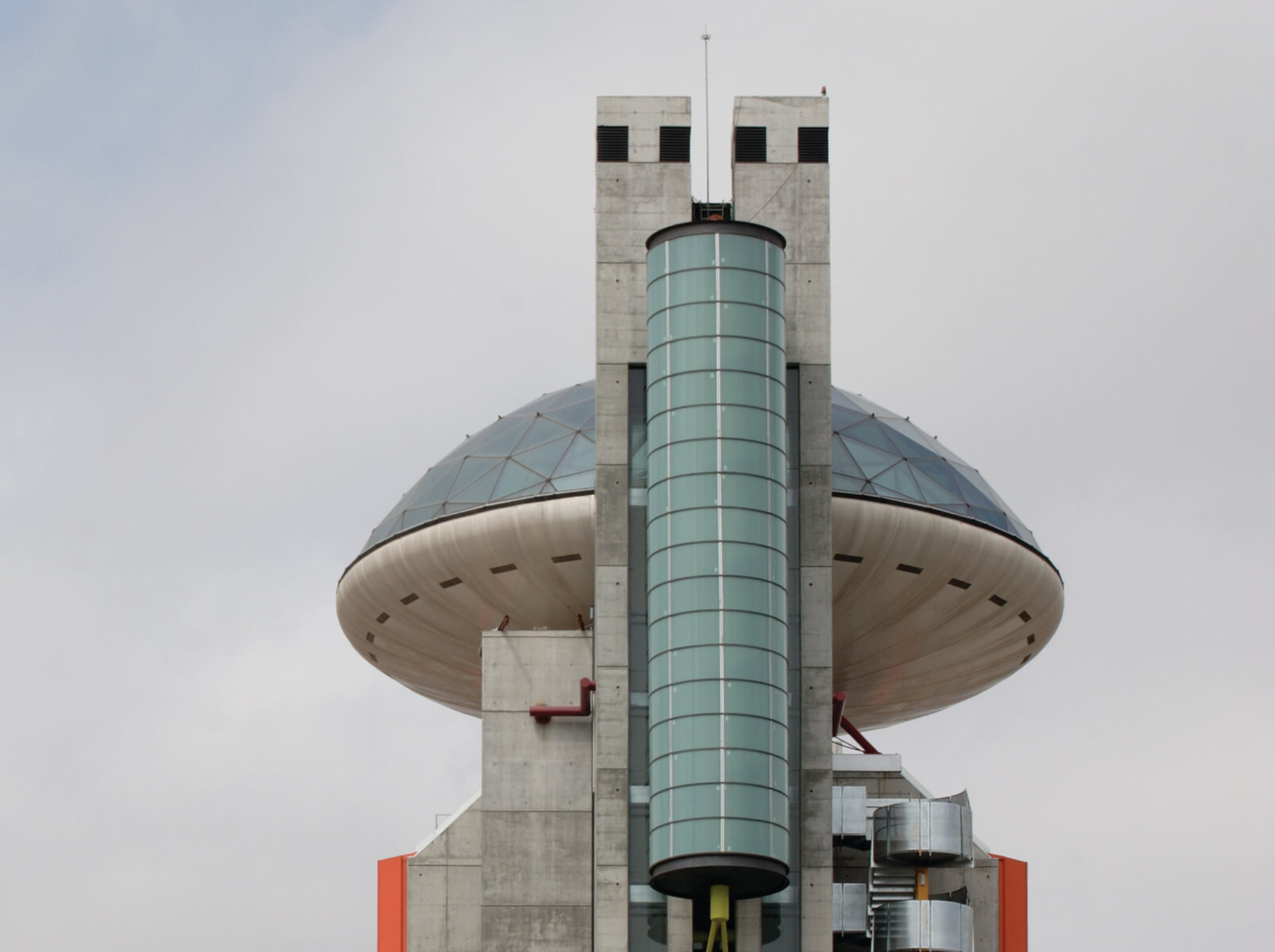
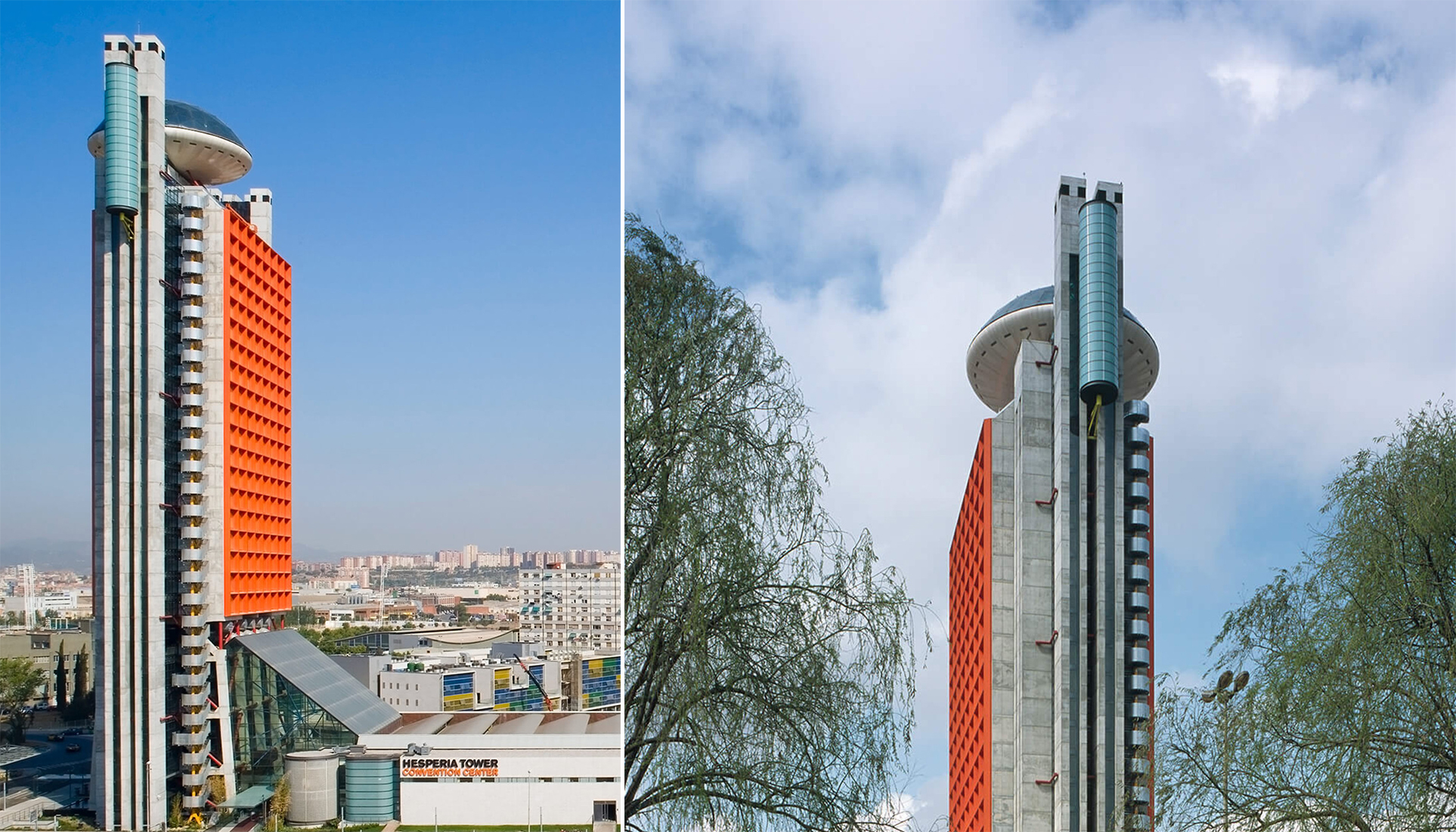
Hesperia Hotel, Barcelona, Spain
This large tower features a bubble-shaped restaurant on the top. Completed in 2006, the tower is broken up into two parts: the vertical arm houses all the hotel rooms whereas the horizontal block at its base contains the offices and other supporting facilities. A large atrium at the base is topped with an angled roof to create a spacious entrance space. The most striking feature is the gridded orange façade of the tower which can be spotted even from a distance. And like Lloyd’s building, the circulation block is added to the eternal surface, running along the entire height of the tower.

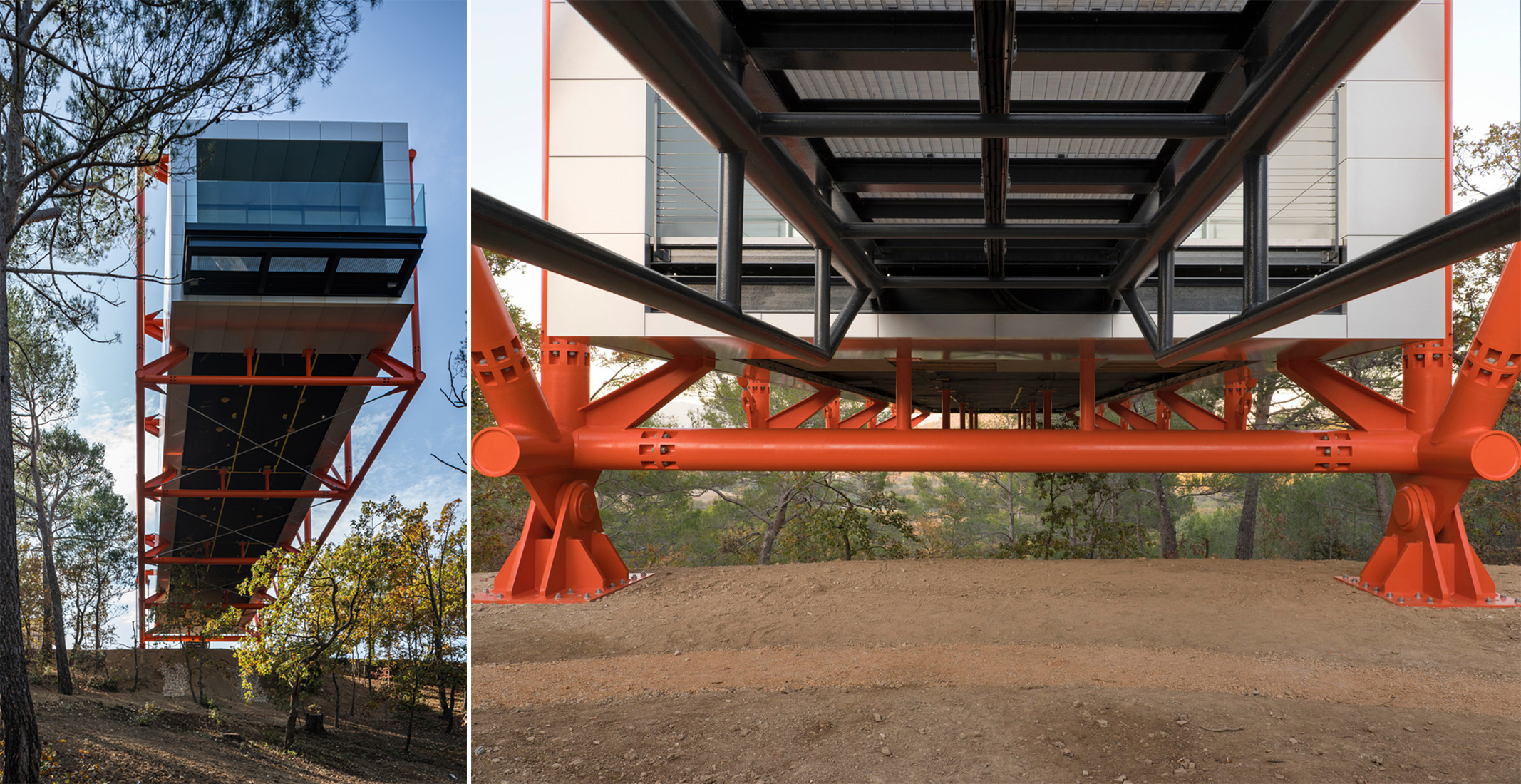
The Richard Rogers’ Drawing Gallery, Provence, France
For the final built project in his long and distinguished career, Rogers picked a remote, elevated site with dense vegetation. A cantilevered concept was chosen to ensure minimal disturbance to the ground below. The mostly opaque block is held up in the air using a contrasting orange structural cage which is anchored to the ground. The building was completed in 2021. Visitors can access this viewing space through a small bridge and then walk onto the other end of the building for spectacular views.
All images used are via Rogers Stirk Harbour + Partners.
Get your work published internationally this year through the 10th Annual A+Awards! The Final Entry Deadline is January 28, 2022. Click here to start your entry today.
The post Structural Expressionism: Richard Rogers’ Design Theory Illustrated in 8 Projects appeared first on Journal.
Did you miss our previous article…
https://thrivingvancouver.com/?p=1020
nine rising City bridges // FCHA
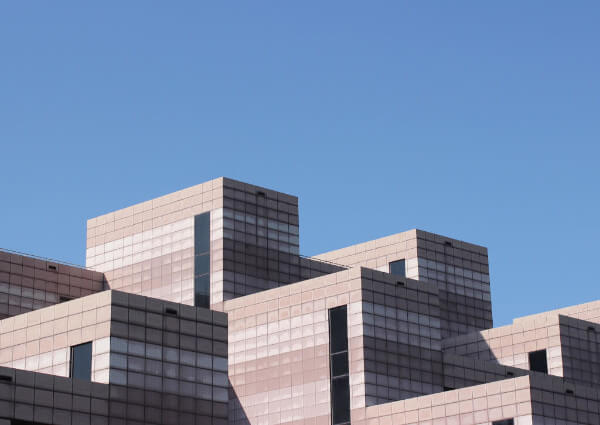
Project Status: BuiltYear: 2020Size: 300,000 sqft – 500,000 sqftBudget: 100M +
Text description provided by the architects.
FCHA collaborates with Vanke Urban Research Institute to plan, design and implement the system, a total of 9 overpasses and weatherproof corridors along the street are set up in the central urban area of Longgang, connecting subway stations, bus stations, businesses and residential areas, which has the originally isolated and closed urban functional groups connected together in a three-dimensional way, which realizes the all-weather three-dimensional and convenient traffic network.In order to achieve a three-dimensional connection in the city, overpasses need to adapt flexibly to the site by turning, extending, undulating and zooming in, that is to adapt to different design conditions through variation and growth on the basis of the same underlying logic.
© FCHA
© FCHA
The enlightenment brought by the Nine Dragons Picture is also the same.
© FCHA
© FCHA
The image of the dragon presents and highlights different emphases in different positions.With “dragon” as inspiration, combined with different locations of the overpasses, different streamline types will be different, four different types of bridges are used in the nine overpasses of the slow traffic system..
© FCHA
© FCHA
nine rising City bridges Gallery
The post nine rising City bridges // FCHA appeared first on Journal.
Did you miss our previous article…
https://thrivingvancouver.com/?p=1017
Building Connection: Cumulus Studio On Crafting Award-Winning Architecture Across Australia
Get your work published internationally this year through the 10th Annual A+Awards! The Final Entry Deadline is January 28, 2022. Click here to start your entry today.
Having recently celebrated their tenth anniversary, Cumulus Studio is a young practice. Established in 2011, this Tasmania-born business has only grows stronger by the year. What started as four individuals with one residential project and big dreams is now a diverse and distinct collaborative workforce distributed across Australia in four studios — Hobart, Launceston, Melbourne, and Adelaide.
Cumulus Studio works in a range of disciplines, although they have distinguished themselves in tourism, social housing and design-led projects in particular. As a practice, they are well known for the collaborative approach that they take to each of their projects, working in teams of mixed specializations and actively encouraging input from external specialists. Thorough workshopping of ideas and initial discussions is the backbone for a program of work that launches with masses of information that can be explored and developed to create concepts that are synergistic to their projects’ culture, heritage, and location. Their specialist process plays a huge part in their distinctiveness and ongoing success.
As Cumulus Studio has regularly been featured in Architizer content and one of the most successful firms in the A+Awards, we spoke with one of the studios four directors, Peter Walker, to discuss the progression of the practice and how winning multiple prestigious awards have helped in the studio’s development and in finding their identity.
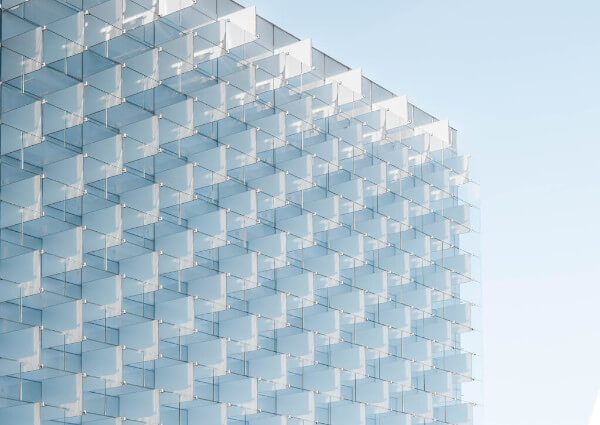
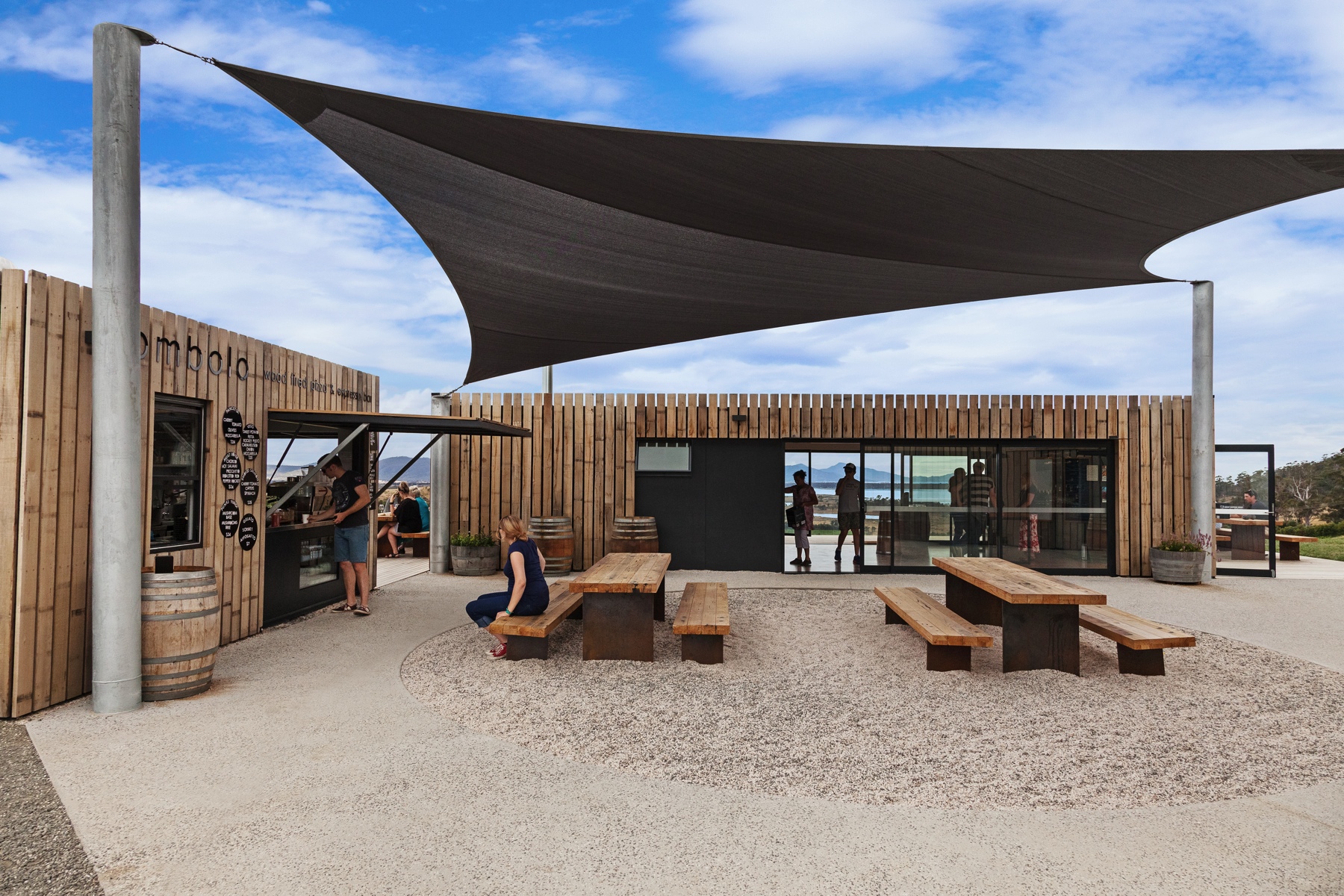
Devil’s Corner by Cumulus Studio, Apslawn, Australia; photographs by Tanja Milbourne
Speaking on their first A+Award win, Peter said, “We first entered the A+Awards program with our Devil’s Corner Cellar Door project which we had recently completed and were really proud of. At the time we were a relatively new practice and, being from a small island state at the bottom of the world, we saw the A+Awards as a way of showcasing our projects to a larger audience.”
Devil’s Corner and its cellar door are a unique tourist experience on the East Coast of Tasmania. Sitting on the boundary of one of Tasmania’s most extensive vineyards, the dynamic modular building is a destination spot for many travellers. Timber-clad shipping containers are positioned and fitted out for a host of functions, from wine tasting, food markets and even weddings. As noted by Peter, the unique project is featured regularly in publications for its well-considered design, function and individuality in a market that can sometimes lack expression. The project deservedly won our Jury Award for a Commercial, Mixed Use space in 2017.
Most recently, the team won the Jury Winner A+Award for Cultural and Expo Centres for their project, The Cradle Mountain Visitor Centre. A stunning piece of geometric work that aimed to honor the significance and sensitivity of the world-renowned Cradle Mountain national park. The project is challenged by its unique and special location. Deep understanding and careful strategy were essential ingredients in their approach, which sought to ensure that the visitor location would be sympathetic to its backdrop while still functioning as a thriving tourist attraction and the attendant heavy footfall.
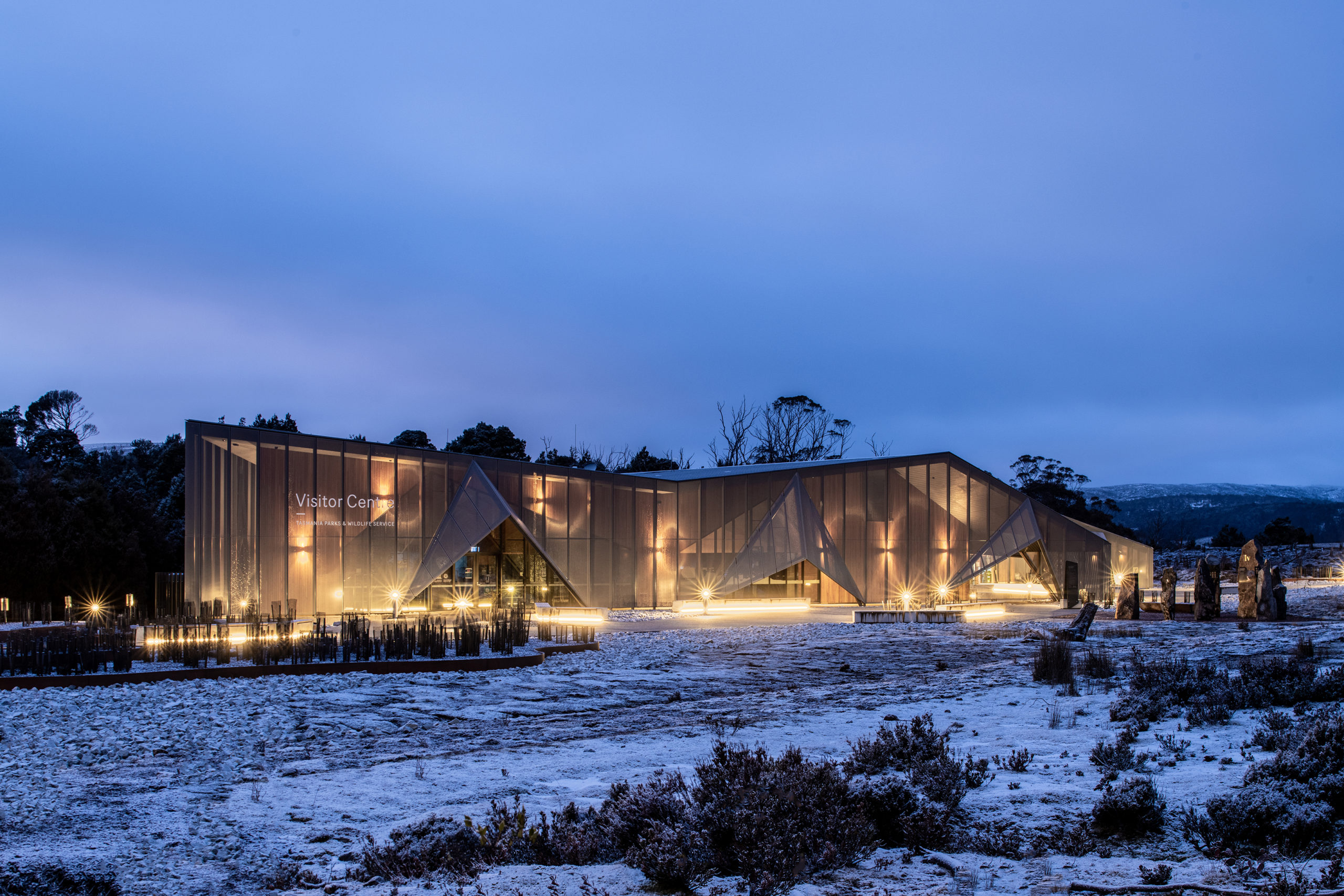

Cradle Mountain Visitor Centre by Cumulus Studio, Tasmania, Australia, 2021 A+Awards Jury Winner in the Transportation Infrastructure and Cultural & Expo Centers categories; photographs by Anjie Blair
The building was designed to feel grounded as if carved from a solid rock by a glacier. The form of the umbrella rain-screen was used to reference the folding angular geology of the mountainous site, while the warm, cave-like timber interior has an Alpine-Esque attraction that is familiar in the glacial landscape. The choice of timber for the interior is about the poetics and qualities of the place. It allows visitors to feel connected to the beautiful all around them, evoking an emotive response while moving through the spaces.
When asked about his favorite detail from their latest win, Peter was keen to discuss the roots of the project as well as recognize the collaboration involved in bringing a project like this to life.
“We have now won three A+Awards. Our most recent project, The Cradle Mountain Visitor Centre, evolved over six years, from an initial feasibility study through Master Planning and the completion of the first stage – the Visitor Services Centre. We worked with artist Alex Miles to create a hanging installation in the main space that interprets the Nothofagus Gunii — Australia’s only cold climate winter deciduous tree and a remnant of the island’s connection to Gondwana. The installation casts shadows and reflects a subtle dappled light, creating texture and depth in the space.”
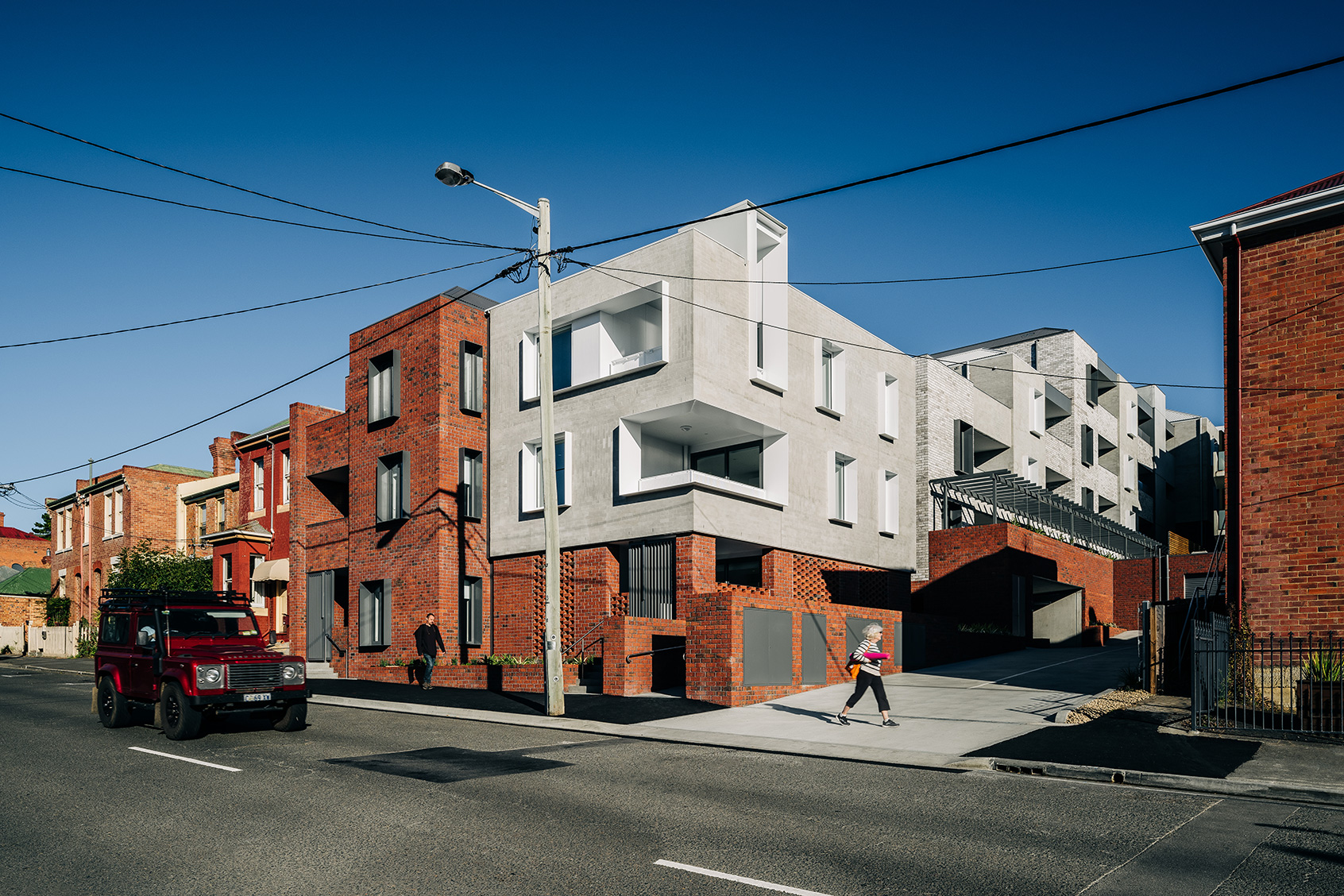

Goulburn Street Housing by Cumulus Studio, Hobart, Australia; photographs by Adam Gibson
Cumulus Studio has a portfolio of unique and distinct projects which will, without doubt, ensure that they continue to grow, develop and surprise for many years to come. However, I believe it is their confidence in what they do and their trust in their well-established process that continue elevating them above their peers, allowing them to bring us exciting and engaging projects like the past winners they have showcased.
Like me, Peter trusts that the future for Cumulus Studio is one that will be bright and momentous. “A large percentage of the work that Cumulus undertakes is within the tourism industry where architecture has the potential to create a meaningful connection or dialogue with the place, landscape, culture, and/or people. We seek to design unique architecture that emerges from and interprets a deep understanding of place and the way that people experience it.”
He add that, “there are some really exciting projects in the studio at the moment and it is exciting that they are spread across a wide range of budgets, locations and typologies.” It is safe to say that we cannot wait to see the inspiring new places that Cumulus Studio has in the works.
Get your work published internationally this year through the 10th Annual A+Awards! The Final Entry Deadline is January 28, 2022. Click here to start your entry today.
The post Building Connection: Cumulus Studio On Crafting Award-Winning Architecture Across Australia appeared first on Journal.
Three Taverns Imaginarium // Square Feet Studio
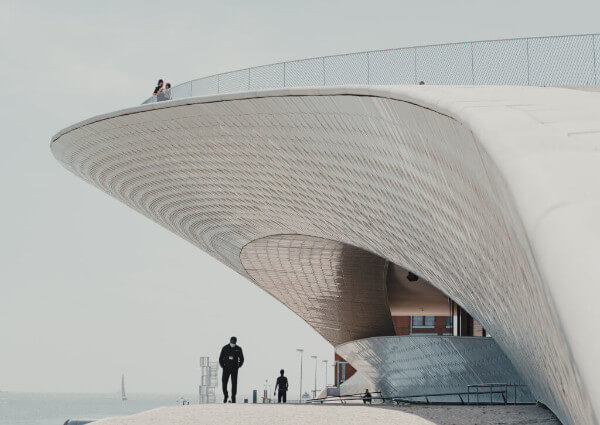
Project Status: BuiltYear: 2020Size: 5000 sqft – 10,000 sqft
Text description provided by the architects.
An old-world cabinet of curiosities meets a modern working brewery: this project is all about escaping into the mind of our client, a creative brewmaster. Our shared philosophy was to feature the beer-making process in a theatrical way, and to create a space that encourages visitors to be curious and embrace new and sometimes unusual styles of beer.
© Square Feet Studio
© Square Feet Studio
Located in an historic adaptive reuse development, the volume of the space our client selected was perfect for the requisite large stainless steel brewing tanks. Our biggest challenge was working with the small but tall footprint to accommodate our client’s desire to maximize guest seating. So, we designed a mezzanine that allows for the complete beer-making process to be viewed from a variety of vantage points.
© Square Feet Studio
© Square Feet Studio
Upon entry, a series of repurposed factory windows delineate the tasting room and draw the curtain back on the production area like a performing arts stage. Rows of polished tanks are arranged below a custom golden mural which artfully hints of the molecular science behind beer-making. Like Alice heading down the rabbit hole, gleaming high gloss blue paneling throughout harkens to old railway carriages, capable of transporting you to another place and time.
© Square Feet Studio
© Square Feet Studio
Following upstairs along a tactile, leather-wrapped handrail, the upper level is tucked beneath the structure of the old building where we created a lounge dotted with intimate seating and glowing lighting. Similar to a theatre mezzanine, here guests can appreciate the art of brewing from above as they peer into the production area.
© Square Feet Studio
© Square Feet Studio
We designed a smaller scale bar upstairs as a true cabinet of curiosities, complete with apothecary paraphernalia and monk figurines, a nod to the Trappist beermasters of Europe. Custom wallpaper features the brightly colored fruits and herbs used to make the flavorful beers produced in the brewery..
© Square Feet Studio
© Square Feet Studio
Three Taverns Imaginarium Gallery
The post Three Taverns Imaginarium // Square Feet Studio appeared first on Journal.
Did you miss our previous article…
https://thrivingvancouver.com/?p=1006
